- Subscribe to newsletter
It's going to be so great to have you with us! We just need your email address to keep in touch.
By submitting the form, I hereby give my consent to the processing of my personal data for the purpose of sending information about products, services and market research of ŠKODA AUTO as well as information about events, competitions, news and sending me festive greetings, including on the basis of how I use products and services. For customer data enrichment purpose ŠKODA AUTO may also share my personal data with third parties, such as Volkswagen Financial Services AG, your preferred dealer and also the importer responsible for your market. The list of third parties can be found here . You can withdraw your consent at any time. Unsubscribe

A Legendary Battle of the 1964 Tour de France: The Underdog vs The Veteran

There can’t be a legendary battle without two equally impressive rivals. The 1964 Tour had Raymond Poulidor and Jacques Anquetil. They both had the skills to win the Tour but they couldn’t be more different. Let’s revisit one of their most memorable battles.
Jacques Anquetil is a cycling legend. He was the first person to win the Tour five times. In 1961, he gained the yellow jersey in stage 1 and held onto it all the way to the last stage. He was a dominant force. He was the man to beat in 1964. His rival, Raymond Poulidor, was raised on a farm and had a huge natural talent. In 1959, he was signed by Mercier, the same team where Anquetil started. After two successful starts at the Tour and a triumph at Vuelta, he was ready to challenge Anquetil for the title in 1964.

Poulidor also had the French fans on his side. He was Anquetil’s polar opposite. Anquetil was called the cycling aristocrat with his high cheekbones, styled blond hair, smooth pale skin, sharp northern French accent, and elegant cycling style. Poulidor was a man of the people, he talked slowly in a middle French accent, had wrinkly sun-tanned skin, and he looked like a pedalling bulldog on the bike.
Their most dramatic confrontation was to happen during stage 20. Anquetil had the yellow jersey but Poulidor was only trailing by 56 seconds. Poulidor’s plan was to attack during the climb to Puy de Dôme and take the overall lead.
The scene was set. They were climbing for 10 kilometres on a steep road up to the famous Puy de Dôme crater. Side by side, shoulder to shoulder, elbow to elbow they were locked together in pain and pushing hard. They could hear each other gasping for air despite half a million fans cheering around them. It was a sight to behold, an intense fight. Poulidor was the favourite because he was the better climber but Anquetil was using his best weapon, strategy. He was taking the inner lane, closer to the mountain. Three times he bluffed pretending he couldn’t match the tempo. Three times Poulidor tried to shake him off without success, exhausting himself. When Poulidor tried attacking again, Anquetil grasped at his jersey knowing he was unable to answer with another attack with his legs. Anquetil lost the moral battle but managed to keep himself in the fight.

“I slowed down, he slowed down. I attacked, he answered. It was unbelievable. I never felt that awful on a bicycle,” admitted Poulidor when recounting the events.
Poulidor succeeded in leaving his rival behind about 500 meters before the top of the climb. Anquetil was losing ground fast but hoped he did enough. Poulidor couldn’t steal the full 56 seconds at that point, could he?
Poulidor won the stage. Anquetil finished after him and nearly collapsed at his team car. He couldn’t catch his breath. His skin turned purple and then white but he still kept counting.
“How many?” he asked.
“You kept 14 seconds,” he heard in response.
“That’s more than I needed,” he gasped in relief.
The final stage was a time trial where Anquetil was a favourite because that was his discipline. Poulidor rode really fast and held on to the fastest time of the day before it was Anquetil’s turn to race. Poulidor was faster in the first half split by 5 seconds. That gave him hope that he might have done enough. Anquetil was a lot faster in the second half and won the time trial and the whole Tour by 55 seconds. At that time, it was the smallest margin in history.

Fans in Paris were not happy that their favourite Poulidor lost and didn’t cheer for the champion. That’s what Anquetil had to deal with. Poulidor was forever the fan favourite but Jacques Anquetil clinched the very important 5th title. But we all got a battle to remember.
Articles you might like

Wheels Roundup: Van der Poel Soloes to Flanders Win, Evenepoel Hits the Cement in Time Trial
Mathieu van der Poel did exactly what was expected in Sunday’s Tour of Flanders by soloing 45 km to another dominant Classics victory to take the third De Ronde victory of his career. He crossed the finish line 1:02 ahead of Luca Mozzato (Arkéa–B&B Hotels)…

Crash Ends Van Aert’s Spring Ambitions – And Perhaps More
Wout van Aert’s Classics season ended in a split second on the road from Roeselare to Waregem in Wednesday’s Dwars door Vlaanderen, when the Visma–Lease a Bike rider was involved in a high-speed crash and suffered a broken collarbone and fractured ribs. The crash occurred…

INEOS Grenadiers Counting on Young Riders to Climb Back to the Top
It has been a mediocre start to the 2024 season for the once mighty INEOS Grenadiers, who under the name Team Sky were the unchallenged lords of road racing from 2012 to 2019. In that eight-year span, they won the Tour de France seven times…

Bicycle Maintenance – When Should I Take My Bike to a Professional?
Understanding when to take your bike to a professional can save you time and money, and ensure your safety on the road or trail. But professional mechanics are expensive so you have to use good judgment for what to do yourself and when to hand…
1964 Tour de France
51st edition: june 22 - july 14, 1964, results, stages with running gc, photos and history.
1963 Tour | 1965 Tour | Tour de France database | 1964 Tour Quick Facts | Final GC | Stage results with running GC | The Story of the 1964 Tour de France
Map of the 1964 Tour de France
The Golden Sayings of Epictetus is available as an audiobook here .
1964 Tour Quick Facts:
4,502.4 km raced at an average speed of 35.420 km/hr.
There were 132 starters and 81 classified finishers.
The 1964 Tour de France was one of the greatest races of all time.
Anquetil had come off his Giro victory that ended just fourteen days before the Tour started and was tired.
His battle with Poulidor culminating in a titanic side-by side climb up Puy de Dôme in stage 20, where Anquetil had conserved just 14 seconds of his lead, is one of the legends of the sport.
Although Anquetil was now the first 5-time Tour winner and the second winner of the Giro-Tour double (after Coppi).
He would never again win a Grand Tour.
Complete Final 1964 Tour de France General Classification:
- Raymond Poulidor (Mercier-BP) @ 55sec
- Federico Bahamontes (Margnat-Paloma) @ 4min 44sec
- Henry Anglade (Pelforth-Sauvage-Lejeune) @ 6min 42sec
- Georges Groussard (Pelforth-Sauvage-Lejeune) @ 10min 34sec
- André Foucher (Pelforth-Sauvage-Lejeune) @ 10min 36sec
- Julio Jiménez (KAS) @ 12min 13sec
- Gilbert Desmet (Wiels-Groene-Leeuw) @ 12min 17sec
- Jans Junkermann (Wiels-Groene-Leeuw) @ 14min 2sec
- Vittorio Adorni (Salvarani) @ 14min 19sec
- Esteban Martin (Margnat-Paloma) @ 25min 11sec
- Fernando Manzaneque (Ferrys) @ 32min 9sec
- Francisco Gabica (KAS) @ 41min 47sec
- Tom Simpson (Peugeot-BP) @ 41min 50sec
- Rudi Altig (St Raphaël-Gitane) @ 42min 8sec
- Karl-Heinz Kunde (Wiels-Groene-Leeuw) @ 42min 16sec
- Joaquin Galera (KAS) @ 43min 47sec
- Henri Duez (Peugeot-BP) @ 46min 16sec
- Joseph Novales (Margnat-Paloma) @ 48min 49sec
- Eddy Pauwels (Margnat-Paloma) @ 50min 2sec
- Arnaldo Pambiano (Salvarani) @ 52min 0sec
- Louis Rostollan (St Raphaël-Gitane) @ 55min 6sec
- Sebastian Elorza (KAS) @ 55min 14sec
- Jan Janssen (Pelforth) @ 59min 31sec
- Battista Babini (Salvarani) @ 1hr 5min 24sec
- Rogelio Hernandez (Ferrys) @ 1hr 8min 16sec
- Claude Mattio (Margnat-Paloma) @ 1hr 13min 45sec
- Raymond Mastrotto (Peugeot-BP) @ 1hr 16min 34sec
- Paul Vermeulen (Mercier-BP) @ 1hr 18min 50sec
- Willy Monty (Pelforth) @ 1hr 23min 26sec
- Jean Gainche (Mercier-BP) @ 1hr 28min 20sec
- Victor Van Schil (Mercier-BP) @ 1hr 30min 13sec
- Edouard Sels (Solo-Superia) @ 1hr 31min 35sec
- Guy Epaud (Pelforth) @ 1hr 33min 12sec
- Jean Stablinski (St Raphaël-Gitane) @ 1hr 34min 10sec
- André Zimmerman (St Raphaël-Gitane) @ 1hr 37min 52sec
- Hubertus Zilverberg (Flandria-Romeo) @ 1hr 41min 30sec
- Albertus Geldermans (St Raphaël-Gitane) @ 1hr 46min 24sec
- Cees Haast (Televizier) @ 1hr 47min 44sec
- Gilbert Desmet (Wiels-Groene Leeuw) @ 1hr 48min 12sec
- Juan Uribezubia (KAS) @ 1hr 49min 33sec
- Camille Vyncke (Flandria-Romeo) @ 2hr 0min 17sec
- Jo De Roo (St Raphaël-Gitane) @ 2hr 0min 23sec
- Luis Otano (Ferrys) @ 2hr 1min 11sec
- José Segu (Margnat-Paloma) @ 2hr 1min 34sec
- Antonio Franchi (Salvarani) @ 2hr 3min 28sec
- Robert Poulot (Mercier-BP) @ 2hr 6min 26sec
- Bruno Fantinato (Salvarani) @ 2hr 6min 35sec
- Benoni Beheyt (Wiels-Groene Leeuw) @ 2hr 8min 7sec
- Italo Mazzacurati (Savarani) @ 2hr 8min 8sec
- Edouard Delberghe (Pelforth) @ 2hr 9min 40sec
- Martín Piñera (KAS) @ 2hr 11min 3sec
- Guillaume Van Tongerloo (Flandria-Romeo) @ 2hr 15min 34sec
- Hubert Ferrer (Pelforth) @ 2hr 15min 59sec
- Antonio Bertran (Ferrys) @ 2hr 18min 38sec
- Michael Wright (Wiels-Groene Leeuw) @ 2hr 19min 8sec
- Bernard Vendekerkhove (Solo-Superia) @ 2hr 21min 29sec
- Michel Van Aerde (Solo-Superia) @ 2hr 21min 57sec
- Robert Cazala (Mercier-BP) @ 2hr 24min 21sec
- Jo De Haan (Televizier) @ 2hr 25min 47sec
- Edgard Sorgeloos (Solo-Superia) @ 2hr 30min 22sec
- Mario Minieri (Salvarani) @ 2hr 31min 29sec
- Pierre Everaert (St Raphaël-Gitane) @ 2hr 32min 9sec
- Rik Wauters (Televizier) @ 2hr 34min 6sec
- Barry Hoban (Mercier-BP) @ 2hr 38min 48sec
- Hank Nijdam (Televizier) @ 2hr 41min 2sec
- André Darrigade (Margnat-Paloma) @ 2hr 41min 9sec
- Willy Berboven (Solo-Superia) @ 2hr 42min 9sec
- Camille Le Menn (Peugeot) @ 2hr 47min 36sec
- Frans Brands (Flandria-Romeo) @ 2hr 48min 28sec
- François Hamon (Peugeot-BP) @ 2hr 50min 23sec
- Vic Denson (Solo-Superia) @ 2hr 57min 23sec
- Antonio Barrutia (KAS) @ 2hr 57min 57sec
- Joseph Groussard (Pelforth) @ 2hr 59min 28sec
- Frans Aerenhouts (Mercier-BP) @ 3hr 3min 6sec
- Jean Grazcyk (Margnat-Paloma) @ 3hr 4min 21sec
- Jean Milesi (Margnat-Paloma) @ 3hr 7min 7sec
- Jean-Pierre Genet (Mercier-BP) @ 3he 12min 55sec
- Jean-Baptiste Claes (Wiels-Groene Leeuw) @ 3hr 12min 57sec
- Salvador Honrubia (Ferrys) @ 3hr 17min 7sec
- Anatole Novak (St Raphaël-Gitane) @ 3hr 19min 2sec
Climbers' Competition:
- Julio Jiménez (KAS): 167
- Raymond Poulidor (Mercier-BP): 90
- Hans Junkermann (Wiels-Groene Leeuw): 47
- Henry Anglade (Pelforth): 44
- Jacques Anquetil (St Raphaël-Gitane): 34
- André Foucher (Pelforth): 33
- Karl-Heinz Kunde (Wiels-Groene Leeuw): 27
- Vittorio Adorni (Salvarani): 26
- Martín Piñera (KAS): 23
Points Competition:
- Edward Sels (Solo Superia): 199
- Rudi Altig (St. Raphaël-Gitane): 165
- Gilbert Desmet (Wiels-Groene Leeuw): 147
- Raymond Poulidor (Mercier-BP): 133
- Jacques Anquetil (St Raphaël-Gitane): 111
- Benoni Beheyt (Wiels-Groene Leeuw), Henk Nijdam (Televizier): 103
- Vittorio Adorni (Salvarani): 83
- André Darrigade (Margnat-Paloma): 78
Team Classification:
- Pelforth: 381hr 33min 36sec
- Wiels-Groene leeuw @ 30min 24sec
- St Raphaël-Gitane @ 30min 52sec
- Margnat-Paloma @ 53min 9sec
- KAS @ 1hr 7min 34sec
- Salvarani @ 1hr 50min 42sxec
- Mercier-BP @ 2hr 2min 53sec
- Ferrys @ 2hr 11min 22sec
- Peugeot-BP @ 2hr 27min 35sec
- Flandria-Romeo @ 4hr 32min 17sec
- Solo-Superia @ 4hr 39m 5sec
- Televizier @ 5hr 35min 10sec
Content continues below the ads
Stage Results with Running GC:
Stage 1: Monday, June 22, Rennes - Lisieux, 215 km
- Edward Sels: 5hr 14min 57sec
- Michael Wright s.t.
- Benoni Beheyt s.t.
- Willy Bocklant s.t.
- Rudi Altig s.t.
- Jo De Roo s.t.
- Jan Janssen s.t.
- Jean Graczyk s.t.
- Frans Melckenbeeck s.t.
- Emile Daems s.t.
GC after stage 1:
- Edward Sels: 5hr 13min 57sec
- Michael Wright @ 30sec
- Benoni Beheyt @ 1min
Stage 2: Tuesday, June 23, Lisieux - Amiens, 208 km
- André Darrigade: 5hr 7min 47sec
- Vito Taccone s.t.
- André Van Aert s.t.
- Frans Verbeeck s.t.
- Gilbert Desmet s.t.
GC after Stage 2:
- Edward Sels: 10hr 21min 44sec
- André Darrigade s.t.
- Jan Janssen @ 30sec
- Willy Bocklant @ 1min
Stage 3A: Wednesday, June 24, Amiens - Forest, 196.5 km
- Bernard Vanderkerkhove: 5hr 7min 32sec
- Jean Stablinski s.t.
- Gilbert Desmet @ 3sec
- Jean Anastasi @ 5sec
- Edward Sels @ 19sec
- Arthur De Cabooter s.t.
GC after stage 3A:
- Bernard Vanderkerhove: 15hr 29min 16sec
- Jan Janssen @ 49sec
- Gilbert Desmet @ 1min 3sec
- Willy Bocklant @ 1min 19sec
Stage 3B: Wednesday, June 24, Forest 21.3 km Team Time Trial.
The rider's real times were applied to their GCs. Team times were caculated by adding up each teams' first three riders' times.
- KAS-Kaskol: 1hr 34min 5sec
- Pelforth-Sauvage-Lejeune @ 8sec
- Wiel's-Groene-Leeuw @ 21sec
- Solo-Superia @ 43sec
- Ferrys @ 1min 17sec
- Mercier-BP @ 1min 25sec
- Peugeot-BP @ 1min 37sec
- St. Raphaël-Gitane @ 1min 43sec
- Salvarani @ 2min 41sec
- Margnat-Paloma @ 3min 49sec
- Flandria-Romeo @ 4min 52sec
- Televizier @ 5min 17sec
GC after stage 3B:
- Bernard Vanderkerkhove: 16hr 52sec
- Jan Janssen @ 39sec
- Michael Wright @ 42sec
- Gilbert Desmet @ 55sec
- José-Antonio Momene @ 1min 4sec
- Francisco Gabica s.t.
- Henry Anglade s.t.
- Carlos Echevarria @ 1min 6sec
- François Mahé @ 1min 9sec
Stage 4: Thursday, June 25, Forest - Metz, 291.5 km
- Rudi Altig: 8hr 26min
- Henk Nijdam s.t.
- Armand Desmet s.t.
- Fernando Manzaneque s.t.
- Edward Sels @ 8sec
- Frans Aerenhouts s.t.
GC after stage 4:
- Bernard Vanderkerkhove: 24hr 27min
- Rudi Altig @ 31sec
- Henry Anglade @ 56sec
Stage 5: Friday, June 26, Metz - Fribourg
- Willy Derboven: 4hr 2min 51sec
- Joaquin Galera s.t.
- Joseph Groussard s.t.
- Georges Groussard s.t.
- Edward Sels @ 4min 2sec
GC after Stage 5:
- Rudi Altig: 28hr 29min 52sec
- Georges Groussard @ 1min 8sec
- Joaquin Galera @ 1min 29sec
- Joseph Groussard @ 3min 25sec
- Bernard Vanderkerhove @ 4min 1sec
- Edward Sels @ 4min 20sec
- Jan Janssen @ 4min 32sec
- Michael Wright @ 4min 43sec
- Gilbert Desmet @ 4min 56sec
- Henry Anglade @ 4min 57sec
Stage 6: Saturday, June 27, Fribourg - Besançon, 200 km
- Henk Nijdam: 5hr 5min 18sec
- Jo De Haan @ 11sec
- Edward Sels s.t.
- Bruno Fantinato s.t.
- Rik Wouters s.t.
GC after Stage 6:
- Rudi Altig: 33hr 35min 21sec
- Bernard Vanderkerkhove @ 4min 1sec
Stage 7: Sunday, June 28, Champagnole - Thonon les Bains, 195 km.
- Jan Janssen: 5hr 2min 14sec
- Vin Denson s.t.
- Henri Duez s.t.
- Jos Hoevenaers s.t.
- Eddy Pauwels s.t.
- Arnoldo Pambianco s.t.
- Raymond Poulidor s.t.
- Hans Junkermann s.t.
- Guy Epaud s.t.
GC after Stage 7:
- Rudi Altig: 38hr 38min 9sec
- Georges Groussard @ 34sec
- Jan Janssen @ 2min 58sec
- Bernard Vandekerkhove @ 4min 1sec
- Sebastian Elorza @ 4min 37sec
- André Foucher @ 4min 42sec
Stage 8: Monday, June 29, Thonon les Bains - Briançon, 248.5 km
- Federico Bahamontes: 7hr 20min 52sec
- Raymond Poulidor @ 1min 32sec
- Hans Junkermann @ 1min 33sec
- André Foucher s.t.
- Jean-Claude Lebaube @ 1min 36sec
- Jacques Anquetil @ 1min 49sec
- Esteban Martin @ 2min 18sec
- Tom Simpson @ 2min 39sec
GC after Stage 8:
- Georges Groussard: 46hr 1min 8sec
- Federico Bahamontes @ 3min 35sec
- Raymond Poulidor @ 4min 7sec
- André Foucher @ 4min 8sec
- Henry Anglade @ 4min 23sec
- Rudi Altig @ 4min 38sec
- Hans Junkermann @ 4min 47sec
- Jacques Anquetil @ 5min 22sec
- Julio Jiménez @ 6min 3sec
- Tom Simpson @ 6min 10sec
Stage 9: Tuesday, June 30, Briançon - Monaco, 239 km
- Jacques Anquetil: 7hr 26min 59sec
- Tom Simpson s.t.
- Vittorio Adorni s.t.
- Claude Mattio s.t.
- Battista Babini s.t.
GC after Stage 9:
- Georges Groussard: 53hr 28min 7sec
- Jacques Anquetil @ 4min 22sec
- Henri Anglade @ 4min 23sec
- Tom Simpson @ 5min 40sec
- Jean-Claude Lebaube @ 6min 17sec
- Esteban Martin @ 6min 53sec
Stage 10A: Wendesday, July 1, Monaco - Hyères, 187.5 km
- Jan Janssen: 5hr 30min 58sec
- Jean-Pierre Genet s.t.
- Guillaume Van Tongerloo @ 4sec
- Edward Sels @ 1min 2sec
GC after Stage 10A:
- Georges Groussard: 59hr 7sec
- Rudi Altig @ 6min 9sec
Stage 10B: Wednesday, July 1, Hyères - Toulon 20.8 km Individual Time Trial
- Jacques Anquetil: 27min 52sec
- Raymond Poulidor @ 36sec
- Rudi Altig @ 54sec
- Ferdi Bracke @ 1min 7sec
- Vittorio Adorni @ 1min 31sec
- Henry Anglade @ 1min 33sec
- Henk Nijdam @ 1min 36sec
- Francisco Gabica @ 1min 44sec
- Miguel Pacheco @ 1min 50sec
- Albertus Geldermans @ 1min 57sec
GC after Stage 10B:
- Georges Groussard: 59hr 30min 50sec
- Jacques Anquetil @ 1min 11sec
- Raymond poulidor @ 1min 42sec
- Federico Bahamontes @ 3min 4sec
- Henry Anglade @ 3min 5sec
- Rudi Altig @ 4min 12sec
- André Foucher @ 4min 16sec
- Hans Junkermann @ 5min 16sec
- Tom Simpson @ 5min 29sec
- Gilbert Desmet @ 6min 3sec
Stage 11: Thursday, July 2, Toulon - Montpellier, 250 km
- Edward Sels: 7hr 49min 28sec
- Jan Graczyk s.t.
- Jo De Haan s.t.
- Antonio Barrutia s.t.
GC after Stage 11:
- Georges Groussard: 67hr 20min 23sec
- Raymond Poulidor @ 1min 42sec
- Rudi Altig @ 4min 7sec
- Tom Simpson @ 5min 24sec
- Gilbert Desmet @ 5min 58sec
Stage 12: Friday, July 3, Montpellier - Perpignan, 174 km.
- Jo De Roo: 4hr 44min 20sec
- Guy Epaud @ 1sec
- Henk Nijdam @ 3sec
- Mario Minieri @ 3sec
- Barry Hoban @ 6sec
- José Segu s.t.
GCafter Stage 12:
- Georges Groussard: 72hr 4min 56sec
- Rudi Altig @ 4min
Stage 13: Saturday, July 4, Perpignan - Andorra, 170 km
- Julio Jiménez: 4hr 54min 53sec
- Benoni Beheyt @ 8min 52sec
- Jacques Anquetil s.t.
- Sebastian Elorza s.t.
GC after stage 13:
- Georges Groussard: 77hr 8min 41sec
- Federico Bahamontes @ 3min 11sec
- Julio Jiménez @ 5min 3sec
Stage 14: Monday, July 6, Andorra - Toulouse, 186 km
- Edward Sels: 4hr 36min 56sec
- Luis Otano s.t.
- Willy Monty s.t.
GC after Stage 14:
- Georges Groussard: 81hr 45min 37sec
- Jacques Anquetil @ 1min 26sec
- Raymond Poulidor @ 4min 28sec
- Gilbert Desmet @ 5min 28sec
- Rudi Altig @ 6min 36sec
Stage 15: Tuesday, July 7, Toulouse - Luchon, 203 km
- Raymond Poulidor: 6hr 7min 55sec
- Francisco Gabica @ 1min 9sec
- Gilbert Desmet @ 1min 43sec
GC after stage 15:
- Georges Groussard: 87hr 55min 15sec
- Raymond Poulidor @ 1min 35sec
- Federico Bahamontes @ 3min 29sec
- Julio Jiménez @ 5min 21sec
- Tom Simpson @ 8min 17sec
Stage 16: Wednesday, July 8, Luchon - Pau, 197 km
- Federico Bahamontes: 6hr 18min 47sec
- Jan Janssen @ 1min 54sec
- Karl-Heinz Kunde s.t.
- Esteban Martin
GC after Stage 16:
- Georges Groussard : 94hr 15min 56sec
- Federico Bahamontes @ 35sec
- Vittorio Adorni @ 11min 13sec
Stage 17: Thursday, July 9, Peyrehorade - Bayonne 42.6 km Individual Time Trial
- Jacques Anquetil: 1hr 1min 53sec
- Raymond Poulidor @ 37sec
- Rudi Altig @ 1min 19sec
- Henry Anglade @ 2min 2sec
- Vittorio Adorni @ 2min 43sec
- Francisco Gabica @ 2min 44sec
- Camille Le Menn @ 2min 55sec
- Gilbert Desmet @ 3min 24sec
- Albertus Geldermans @ 3min 41sec
- Barry Hoban @ 3min 51sec
GC after Stage 17:
- Jacques Anquetil: 95hr 18min 55sec
- Raymond Poulidor @ 56sec
- Federico Bahamontes @ 3min 31sec
- Henry Anglade @ 4min 1sec
- Georges Groussard @ 4min 53sec
- André Foucher @ 7min 30sec
- Gilbert Desmet @ 7min 46sec
- Hans Junkermann @ 9min 2sec
- Julio Jiménez @ 11min 10sec
- Vittorio Adorni @ 12min 50sec
Stage 18: Friday, July 10, Bayonne - Bordeaux, 187 km
- André Darrigade: 5hr 5min 12sec
- Barry Hoban s.t.
- Michel Van Aerde s.t.
- Edgar Sorgeloos s.t.
- Mario Minieri s.t.
GC after Stage 18:
- Jacques Anquetil: 100hr 24min 7sec
- Gilbert Desmet @ 7min 43sec
Stage 19: Saturday, July 11, Bordeaux - Brive, 215.5 km
- Edward Sels: 5hr 50min 30sec
- Mario Minieri @ 1sec
- Frans Aerenhouts @ 2sec
- Henk Nijdam @ 4sec
- Jean Gainche s.t.
GC after Stage 19:
- Jacques Anquetil: 106hr 14min 41sec
Stage 20: Sunday, July 12, Brive - Puy de Dôme, 237.5 km
Major ascents: St. Privat, Puy de Dôme
- Julio Jiménez: 7hr 9min 33sec
- Federico Bahamontes @ 11sec
- Raymond Poulidor @ 57sec
- Vittorio Adorni @ 1min 30sec
- Jacques Anquetil @ 1min 39sec
- Henry Anglade @ 1min 59sec
- André Foucher @ 2min 4sec
- Francisco Gabica @ 2min 32sec
- Fernando Manzaneque @ 2min 46sec
- Jan Janssen @ 3min 22sec
GC after Stage 20:
- Jacques Anquetil: 113hr 25min 53sec
- Raymond Poulidor @ 14sec
- Federico Bahamontes @ 1min 33sec
- Henry Anglade @ 4min 21sec
- Georges Groussard @ 6min 49sec
- André Foucher @ 7min55sec
- Julio Jiménez @ 8min 31sec
- Gilbert Desmet @ 10min 25sec
- Hans Junkermann @ 10min 49sec
- Vittorio Adorni @ 14min 41sec
Stage 21: Monday, July 13, Clermont Ferrand - Orléans, 311 km
- Jean Stablinski: 9hr 29min 33sec
- Battista Babini @ 1sec
- Hubert Ferrer s.t.
- Joseph Novales s.t.
- Salvador Honrubia s.t.
- Edward Sels @ 9min 37sec
- Benoni Beheyt
GC after Stage 21:
- Jacques Anquetil: 123hr 5min 3sec
- André Foucher @ 7min 55sec
- Vittorio Adorni @ 12min 41sec
Stage 22A: Tuesday, July 14, Orléans - Versailles, 118.5 km
- Benoni Beheyt: 3hr 25min 24sec
- Edward Sels @ 7sec
- Victor Van Schil s.t.
GC after stage 22A:
- Jacques Anquetil: 126hr 32min 54sec
- Raymond poulidor @ 14sec
Stage 22B (final stage): Tuesday, July 14, Versailles - Paris 27.5 km Individual Time Trial
- Jacques Anquetil: 37min 10sec
- Rudi Altig @ 15sec
- Raymond Poulidor @ 21sec
- Vittorio Adorni @ 1min 18sec
- Gilbert Desmet @ 1min 32sec
- Henry Anglade @ 2min 1sec
- Albertus Geldermans @ 2min 6sec
- Camille Le Menn @ 2min 15sec
- André Foucher @ 2mn 21sec
Complete Final 1964 Tour de France General Classification
The Story of the 1964 Tour de France:
This excerpt is from "The Story of the Tour de France", Volume 1. If you enjoy it we hope you will consider purchasing the book in either print, eBook or audiobook formats. The Amazon link here will make the purchase easy.
Anquetil started the 1964 season well. He won Ghent-Wevelgem and then the Giro d'Italia. If he won the 1964 Tour he would achieve the Giro-Tour double, a feat previously accomplished in the same year only by Fausto Coppi. He would also perform the then-unequaled feat of winning the Tour de France for a fifth time.
He had taken the 1964 Giro lead in the stage 5 time trial and had held the leader's Pink Jersey for the rest of the race. Subjected to relentless attacks, he was forced to work especially hard to defend his lead in the Giro. The effort left him exhausted. Many wondered if Anquetil could ride an effective Tour that started just 2 weeks after this brutal Giro ended. Anquetil was aiming for the stars. While his 4 Tour wins were the record, a fifth win while doing a Giro-Tour double would make him one of the greatest racers in history.
There were no new challengers on the Tour scene so the main contenders for the 1964 Tour were the same as the year before, Bahamontes and Poulidor.
Poulidor brought excellent form to the 1964 Tour. He won the 1964 Vuelta a España, which was then run early in the year, as well as the Critérium National. He was second at Milan–San Remo and the Dauphiné Libéré and fourth in Paris-Nice. He had every right to expect that he would do well and possibly even win the Tour.
Let's stop a minute and take a look at Raymond Poulidor.
The battles between Poulidor and Anquetil enlivened racing (and arguments between racing fans) as much in France as the Bartali-Coppi contests fired up the Italians a generation before. Poulidor was the superior climber and Anquetil was the better time trialist. Poulidor was never able to gain enough of an advantage in the mountains to make up for his losses against the clock. Anquetil was also the superior tactician and psychologist. When his physical limits threatened his chances he could call upon his superior intellect and salvage a race. This was a gift denied Poulidor.
Here is Pouildor's Tour Record:
By the years:
Here's a selection of other Poulidor wins: Milan–San Remo, Fleche Wallonne, Grand Prix des Nations (even though he wasn't a time trialist of Anquetil's caliber, he was still very, very good against the clock), Vuelta a España, Critérium National, Dauphiné Libéré, Catalonian Week and Paris–Nice.
In 1974, at the Montreal World Road Championships, only 39-year old Raymond Poulidor could stay with Eddy Merckx when he attacked on the last time up Mount Royal, finishing just 2 seconds behind the great man. If anyone could paraphrase Raphaël Géminiani this time, it was Poulidor. He was first because he was the first human across the line. No normal person was going to beat Merckx that day.
This was an extraordinary career by any measure.
In the wars for the affection of the French people, Poulidor won hands down. It baffled and angered Anquetil that even though Anquetil could beat Poulidor over and over again, "Pou-Pou", the "Eternal Second" was first in the French hearts and remains there today. I have often thought that Poulidor tapped into a piece of the French psyche that made Crecy and Agincourt possible. It was at Crecy, France that the English with their technically superior longbows slaughtered the French armored knights. Later, at Agincourt, the French knights jostled for position to be first to hurl themselves against the English longbowmen only to be slaughtered again. Le Gloire (glorious renown) isn't necessarily gained by victory.
To continue:
The 1964 Tour was 4,504 kilometers divided into 25 stages going clockwise, Alps first then the Pyrenees. To increase the drama the Tour would head into the Massif Central and climb the Puy de Dôme, an extinct volcano whose final 5 kilometers have a gradient that approaches 13%.
For the first part of the Tour as the race sped east from Rennes in Brittany, Anquetil was unremarkable. He knew he had a finite supply of energy and had announced in advance his plans to let others do the racing in the first week. He didn't even place in the top 10 of a stage until stage 8.
His teammate Rudi Altig, however, did have early ambitions. After passing through Brittany and Normandy, the Tour headed into Belgium and then southeast into Germany. Altig wanted to be wearing the leader's jersey while the Tour went through his home country. By winning the fourth stage into Metz he was in an excellent position to realize his ambition. He had the Green Points Jersey and was only 31 seconds behind the current leader, Bernard van de Kerckhove.
The next stage traveled through the Vosges, hilly country in eastern France that encouraged breakaways. Altig powered a 5-man break 4 minutes clear of the field into Fribourg and secured the overall lead. Rudi Altig the German rider was in Yellow in Germany. Anquetil was not entirely pleased that his teammate had been so successful. In that break was a rider on the Pelforth team, Georges Groussard, who was now in second place, only a minute behind Altig. Groussard was an excellent rider with fine climbing skills and Altig had given him a 4-minute boost. Anquetil did not relish the prospect of overcoming that time gain just so that Altig could enjoy a little bit of German glory.
Stage 7 went through the Jura, mountains on the northeastern edge of the Alps. Tongues wagged when Poulidor got into a 15-man break that included Groussard and left the rest of the peloton (with Anquetil) a half-minute behind. Altig was still in Yellow but Poulidor had stolen a march on a very obviously tired Anquetil.
Stage 8 was the first full-blown Alpine stage with both the Télégraphe and the Galibier. Bahamontes was first over both summits. Poulidor went after him on the Galibier and came close to making contact with the flying Spaniard. Meanwhile, Anquetil was suffering, losing time on the climb. Once over the top he used his considerable descending skills to try to close the gap. Even with a flat tire he was still able to limit his losses to Poulidor to only 17 seconds. Bahamontes won the stage, Poulidor came in second and thereby gained a 3 second time bonus. Anquetil's worries about Groussard turned out to be completely justified. The Pelforth rider was now in Yellow.
So, after the first day of hard climbing here were the standings:
Anquetil showed he was up for the race the next day in the Briançon-Monaco stage which took in 3 major climbs. None of the contenders was able to get away from the others, and 22 riders came into Monaco, driven hard by an Anquetil who had miraculously found incredible stores of energy. It was a track finish Poulidor should have won, but he sprinted too early, not realizing that there was another lap to ride. Anquetil beat Tom Simpson for the stage. Poulidor's missing (and Anquetil's winning) the time bonus for winning the stage would loom very large at the end of the Tour. Anquetil was now in fifth place, 4 minutes, 22 seconds behind Groussard.
Stage 10b was a 20.8-kilometer time trial and Anquetil won it with Poulidor just 36 seconds behind.
Anquetil was relentlessly hunting Groussard and getting closer by the day. The General Classification after the 10b time trial:
By the time the Tour came to its rest day in Andorra in the Pyrenees, the only significant change in General Classification was that Bahamontes had dropped to fifth. Good Grand Tour riders always go for a ride on the rest day. The body has become habituated to cycling and a day completely off the bike makes it very difficult to start the next day, the rider's legs are "blocky" and devoid of power. Poulidor and the others dutifully gave their bodies the exercise they needed. Everyone but Anquetil, that is. Jacques liked to enjoy life. He went to a picnic and enjoyed himself on big portions of barbecued lamb and as usual, drank heartily. His director, Raphaël Géminiani, was there and apparently encouraged the drinking.
At the start of the Tour a psychic had predicted that Anquetil would abandon on the fourteenth stage after suffering an accident. Anquetil could be a coolly rational man but he took this prediction seriously. It's thought that he behaved in this self-destructive way at the barbecue because he believed he would probably not finish the stage the following day.
The next day, stage 14, Party Boy didn't even bother to warm up. Poulidor's manager, Antonin Magne, knew that Anquetil would be vulnerable after his day of excess and instructed Poulidor to drop the hammer on the first climb. The other contenders, including Federico Bahamontes, Julio Jimenez and Henry Anglade, also sensed Anquetil's weakness and poor preparation and attacked furiously. The climbing out of Andorra up the Port d'Envalira, a climb new to the Tour that year, started almost immediately. Anquetil was quickly put out the back door. The hard profile of the day's early kilometers gave Anquetil no chance to warm up. At the top, Anquetil was about 4 minutes behind the leaders and was contemplating quitting. He had even loosened his toe-straps.
One of his domestiques , Louis Rostollan, who had stuck with him on the climb shouted at him, "Have you forgotten that your name is Anquetil? You have no right to quit without a fight!" Team director Géminiani came up to Anquetil and bellowed his rage, screaming at him to chase the leaders, to give it all he had in the descent. The story goes that Géminiani gave Anquetil a bottle with champagne in it. With this restorative circulating in the bon vivant's system, he could now effectively compete
Anquetil was by now warmed up. He could use his superb descending skill to catch the leaders through the dense fog on the descent.
Into that fog Anquetil went, riding like a man possessed, taking risks no man should take. He used the headlights and brake lights of the following cars to let him know when to slow for corners. He caught the group with Henry Anglade and Georges Groussard and made common cause with them. From the crest of the Envalira it was 150 kilometers to the finish. Given good fortune he had enough time and distance to salvage his Tour. Using his time trialing skills he made it up to the Poulidor/Bahamontes lead group.
With just a few kilometers to go Poulidor flatted and got a new wheel. His mechanic, in a zeal to make sure he didn't lose any more time, pushed Poulidor before he was ready and caused him to crash. By the time Poulidor was up again and riding Anquetil's group was gone. Poulidor came in with the second group, 2 minutes, 36 seconds behind Anquetil.
Here were the standings after that hair-raising adventure:
The story of Anquetil's Tour being saved with a bidon of champagne is romantic, but Anquetil's wife Jeanine insisted that it wasn't true.
Poulidor hadn't given up yet. Stage 15 was a ride over the Portet d'Aspet, the Ares and the Portillon. Poulidor won it and gained 1 minute, 43 seconds back from Anquetil.
There was still 1 monumental, monstrous day of climbing left. 1 day remained for the pure climbers to try to reclaim the Tour. There were still 2 time trials left to ride, totaling 70 kilometers where Anquetil could easily wipe out his 86 second deficit. He had only to ride defensively and not lose more time, the usual Anquetil formula. Stage 16 was 197 kilometers long and had the Peyresourde, the Aspin, the Tourmalet and the Aubisque climbs. The road turned upward almost immediately with the slopes of the Peyresourde coming at the fourteenth kilometer. Bahamontes took off after only 4 kilometers, quickly followed by his compatriot Julio Jimenez. When they reached the crest of the Peyresourde, Bahamontes let Jimenez take the lead and the climber's points. Bahamontes was looking for bigger fish than the King of the Mountains. He smelled Yellow. Over the Aspin Bahamontes again let Jimenez take the lead over the top. The Anquetil group was 3 minutes back at this point. At the top of the Tourmalet the Anquetil group was over 5 minutes back. But Bahamontes could not descend well and his lead was halved. On the Aubisque Jimenez could no longer stay with Bahamontes. Alone, Bahamontes soared to a lead of over 6 minutes at the top. Back in the field the Pelforth domestiques were rallying and chasing, trying to defend Groussard's Yellow Jersey. On the run-in to Pau Bahamontes's lead was slowly eroded until it was 1 minute, 54 seconds at the end. Bahamontes had been away for 194 kilometers. It was a wonderful ride, but he hadn't gained enough time to hold off Anquetil in the time trials. With 1 of the time trials the very next day, he was surely toast. And Poulidor? He sat in the entire day, recovering from his stage win the day before. Anquetil noted that if Poulidor should win the Tour that year, he should thank Anquetil for the work he did that day holding Bahamontes in check.
The new General Classification:
And then, what must have seemed to be the inevitable happened. Anquetil won the 42.6-kilometer time trial, beating the day's second place Poulidor by 37 seconds. Bahamontes was twelfth, 4 minutes back. Anquetil was now the leader, ahead of Poulidor by 56 seconds. Bahamontes was third at 3 minutes, 31 seconds. Groussard paid the price defending the Yellow for 10 days, and lost 6 minutes. It was now a 2-man race.
Stage 20, with its finish at the top of the Puy de Dôme, was the scene of the 1964 Tour's most dramatic showdown. The Puy de Dôme is an extinct volcano in the center of France. It has an elevation gain of 515 meters in only 6 kilometers. It averages 9%, but gets steeper as the road approaches the summit. The tenth kilometer is almost 13% before it backs off a bit to between 11 and 12%. The final kilometer is still a tough 10%. With such a hard incline, its total 14 kilometers could transform the Tour. Poulidor was the better climber and a tired Anquetil knew it.
Probably 500,000 spectators lined the roads of the old volcano, sure that there would be fireworks that day. Upon reaching the Puy, Julio Jimenez and Federico Bahamontes took off up the mountain. This was as Anquetil wanted. This break took the time bonuses out of play. Poulidor would be riding for just the time gain he might acquire by beating Anquetil if he were so lucky. Poulidor and Anquetil were otherwise unconcerned about the Spanish escape because neither Jimenez nor Bahamontes would be likely to take the Yellow. They were worried about each other. Instead of sitting on Poulidor's wheel, Anquetil rode next to him trying to gain the psychological edge. Neither felt very well. "I never felt again as bad on a bike," Poulidor said later. Anquetil felt worse.
As they closed in on the summit, Poulidor attacked and Anquetil stayed with him. "All I cared was that I was directly next to Raymond. I needed to make him think I was as strong as he, to bluff him into not trying harder."
Poulidor attacked again. Anquetil stayed with him. There is a famous picture of Anquetil and Poulidor bumping into each other while climbing the volcano, neither giving in the slightest bit; each trying to cow the other; each riding at his limit.
Passing under the Flamme Rouge (1 kilometer to go flag), Anquetil's attention lapsed for just a moment and he let Poulidor go. There was nothing Anquetil could do. He was spent. Poulidor poured on the gas, racing for the finish line and hoping to erase the 56-second deficit and finally don the Yellow Jersey. He waited at the finish, counting off the seconds.
Anquetil crossed the line, limp with exhaustion, 42 seconds later. He had saved his lead by 14 seconds. Magne, Poulidor's manager, believes that Poulidor could have won the Tour that day if he had used a 42 x 26 as Bahamontes used instead of the 25 that he led Magne to believe was the right choice.
There was the formality of the final time trial in which Anquetil put another 21 seconds between himself and Poulidor. With the time bonus, Anquetil won his astounding fifth Tour de France by 55 seconds over Poulidor.
Poulidor said, "I know now that I can win the Tour."
Final 1964 Tour de France General Classification:
© McGann Publishing
Official games
2023 Edition
- Stage winners
- All the videos
Tour Culture
- Commitments
- key figures
- Sporting Stakes
- "Maillot Jaune" Collection
- The jerseys

One day One story - 1964: A duel at the summit on the Puy-de-Dôme
The 2020 Tour was originally scheduled to take place from 27 June to 19 July. To keep the flame of the race burning, letour.fr will relive every day a glorious or curious race event that happened two, fifteen or forty years ago. A trip down memory lane…
Anquetil versus Poulidor was a duel that stoked the fire of cycling debate and far beyond, dividing France into two clans, with each side finding something that appealed to them in the opposing styles and temperaments of the two riders. Already a four-time winner of the race, “Master Jacques” was decked out in yellow when he came under threat on the climb up the Puy-de-Dôme, the venue for their most memorable bout of sparring. Although the stage had already been won by Julio Jiménez, Poulidor managed to break away and leave his great rival in his wake during the last kilometre, gaining forty seconds. In the end Anqueti still managed to hang on to the lead in the general classification and put one hand on his fifth title.

You may also enjoy

Biofreeze, a refreshing wind on the Tour de France

IBIS STYLES AND IBIS BUDGET JOIN THE TOUR DE FRANCE

D-100: ITALY TURNS YELLOW
Receive exclusive news about the Tour

Accreditations
Privacy policy, your gdpr rights.
- As it happened - A reduced sprint finish in the rain at Itzulia Basque Country stage 2
What is the Puy de Dôme? Inside the legendary Tour de France climb
All you need to know about the historic Tour de France summit finish
The Puy de Dôme is simultaneously somehow a new and old legendary Tour de France. Its status was burnished decades ago, helped by battles between cycling champions, its difficulty, its impact on the sport’s race and its unique appearance.
This verdant, volcanic plug and its white observatory tower is visible on the horizon around the Auvergne and the city of Clermont-Ferrand below. When covered by cloud, it can appear to be floating in the sky.
When the 2023 Tour de France visits the Puy de Dôme for the finale of stage 9, it will be like greeting a long-lost friend. It has not been included in the race since 1988, when Dane Johnny Weltz was the stage winner.
Its presence in the race will provoke a twinkle in the eye of those who can recall the great battles of yesteryear. This climb from a bygone era of toe clips and wool jerseys is back for a showdown.
Tour de France- the ultimate guide Tour de France - the complete route Tour de France - past winners
On this Massif Central ascent, characterised by its green and gruelling final four kilometres, legends showed their greatness.
The Puy de Dôme made its debut in the race in 1952 when Fausto Coppi was victorious on the way to a dominant Tour de France victory.
Eventual race winner Federico Bahamontes made up most of his deficit with an emphatic time-trial win there in 1959. However, the climb is still associated with Jacques Anquetil, Raymond Poulidor and the electrifying duel the pair fought up the climb 48 hours before the end of the 1964 Tour de France.
Get The Leadout Newsletter
The latest race content, interviews, features, reviews and expert buying guides, direct to your inbox!
As the kilometres ticked by slowly, they rode together side-by-side and neck-and-neck, with the rock wall to their right. Neither gave in or pulled away. At last, bent over the bike and grinding slowly in the saddle, yellow jersey-clad Anquetil dropped back in the final kilometre.
The battle was lost, but he kept the race lead by 14 seconds and his fifth and final Tour win would be won. A nation was captivated and the Puy de Dôme’s place in cycling folklore was assured. Fittingly, the 182.4km ninth stage of the 2023 Tour de France which finishes there will start in Poulidor’s home of Saint-Léonard-de-Noblat.

Regularly appearing in the final week of the Tour de France over the next 25 years, the Puy de Dôme could both decide the race’s kings and contribute to dramatic dethronings.
In 1975, Eddy Merckx was punched in the kidneys by a spectator close to the finish, an incident which contributed to his toppling by Bernard Thévenet two days later. It would be the last time Merckx ever wore the Tour’s yellow jersey in competition.
Eleven years later, Greg LeMond made good his advantage over Bernard Hinault, putting almost a minute into his La Vie Claire teammate to win the 1986 Tour.
Following its appearance in 1988, it was increasingly thought that a finish on the Puy de Dôme would be logistically impossible. The Tour appeared to have outgrown the mid-France climb, given the size of its organisation and commercial caravan. The train line built to the top in 2012 also narrowed the road even further. (The tarmac is not for public use, save for emergencies and services. However, one day a year, it is open to cyclo-tourists to ride up and test their mettle.)
However, the dream to include this evocative mountain in the modern Tour has been there for decades. “When I started at ASO in January 2004, the first thing I typed on my computer was: objective, Puy de Dôme. For me, it’s one of the strongest symbols of the Tour de France’s legend,” race director Christian Prudhomme told AFP .
The 13.3-kilometre climb averages 7.7 percent gradient, but it has three distinct, different sections. The opening third, rising west from the outskirts of Clermont-Ferrand, averages approximately seven per cent before a gentler few kilometres of borderline false flat allow a slight breather.
From the Parking du Panoramique du Dôme, there’s no hiding. The road carries on to the finish for 4 kilometres at over 11 percent gradient. As the road curls round the volcano like a snail shell, some riders will feel like they’re inching along as slowly as that little mollusc. It cannot fail to break up the race and have an impact.
We tend to think of mountains like versions drawn by children: rocky expanses with elaborate hairpin bends and jagged, snow-capped tops. Not the Puy de Dôme, which tops out at 1,415 metres and has greenery as far as the eye can see. The views west over other summits in the Parc naturel régional des Volcans d’Auvergne are extensive.
There are no corners on the narrow road up, which hugs the volcano, climbing up next to the rail line which takes visitors to the top on a panoramic train. That will add psychological pain to go with the physical suffering for racers, who will have to judge their effort adroitly. Even on the last leg-hurting ramp of 18 per cent, the finish hides tantalisingly from sight.
“It’s very, very steep. I don’t think I’ve ever been up a climb like this. There is no respite. Without any corners, you have to keep the power on the pedals endlessly,” Jonas Vingegaard said after a reconnaissance ride. The Puy de Dôme will also stand out for the silence and emptiness in its last part. It is just one of 80 volcanoes in the Chaîne des Puys, a UNESCO World Heritage Site. Accordingly, there will be no spectators allowed in the final four kilometres to help preserve its flora and fauna.
Heat-seeking drones will even be in the skies in the days before the race’s arrival, seeking out any bold campers trying to hide in the undergrowth. During stage nine of the 2023 Tour de France, a minimal number of race vehicles will be permitted to follow the peloton, given the narrow width of the road.
Around the world, millions in a whole new generation will tune in to savour the return of the Puy de Dôme to the Tour de France. It’s down to the likes of Tadej Pogačar, Jonas Vingegaard and local hero Romain Bardet to be the authors of new myths and legends. Many will no doubt hope to see this brutal and beautiful climb in a top bike race again very soon.

Thank you for reading 5 articles in the past 30 days*
Join now for unlimited access
Enjoy your first month for just £1 / $1 / €1
*Read any 5 articles for free in each 30-day period, this automatically resets
After your trial you will be billed £4.99 $7.99 €5.99 per month, cancel anytime. Or sign up for one year for just £49 $79 €59

Try your first month for just £1 / $1 / €1
Formerly the editor of Rouleur magazine, Andy McGrath is a freelance journalist and the author of God Is Dead: The Rise and Fall of Frank Vandenbroucke, Cycling’s Great Wasted Talent
The best cycling watches of 2024 - track your fitness on and off the bike
Tour of Flanders gallery: Mathieu van der Poel and Elisa Longo Borghini's spectacular triumphs in pictures
Itzulia Basque Country: Paul Lapeira wins slippery sprint in rain on stage 2
Most Popular
By Stephen Farrand March 28, 2024
By Barry Ryan March 28, 2024
By Barry Ryan March 27, 2024
By Barry Ryan March 26, 2024
By Kirsten Frattini March 25, 2024
By Fabian Cancellara March 25, 2024
By Barry Ryan March 23, 2024
By Fabian Cancellara March 23, 2024
By Kirsten Frattini March 23, 2024
By Alasdair Fotheringham March 23, 2024
By Paul Norman March 22, 2024
- accéder au contenu
- accéder au menu principal
- contactez-nous
- direct radio
- Gouvernement de Gabriel Attal
- Assemblée nationale
- Emmanuel Macron
- Réforme des retraites 2023
- Les Républicains
- Renaissance
- Rassemblement national
- Parti socialiste
- La France insoumise
- Les Ecologistes - EELV
- Election présidentielle
- Toutes les élections
- Élections européennes 2024
- Egalité femmes-hommes
- Immigration
- Maltraitance dans les Ehpad
- Droits des femmes
- Violences sexuelles
- Féminicides
- Prostitution
- Calendrier des vacances scolaires
- Résultats Bac
- Résultats Brevet
- Résultats Bts
- Résultats Cap
- Harcèlement scolaire
- Enlèvements
- Justice – Procès
- Incendies de forêt
- Mort de Nahel à Nanterre
- Disparition de Delphine Jubillar
- Attaque au couteau à Annecy
- Procès de l’attentat de Magnanville
- Disparition du petit Emile
- Incendie meurtrier à Wintzenheim
- Vaccin contre le Covid-19
- La crise de l’hôpital public
- Biologie - Génétique
- Alimentation
- Lutte contre le tabagisme
- Politique de santé
- Psycho - Bien-être
- Sport et santé
- Professions médicales
- Le tabou de la santé mentale
- Pouvoir d'achat
- Impôts - Fiscalité
- Entreprises
- Auto-entrepreneurs
- Aéronautique
- Budget de la France
- Soldes d'hiver 2024
- Asie-Pacifique
- Etats Unis d'Amérique
- Proche-orient
- Guerre en Ukraine
- Sommet de l'UE
- Royaume-Uni
- Story Killers
- Conflit dans le Haut-Karabakh
- Guerre entre Israël et le Hamas
- Inondations meurtrières en Libye
- Séisme au Maroc
- Festival de Cannes 2024
- Oscars 2024
- Victoires de la musique 2024
- Festival du livre de Paris 2024
- Les Molières
- Fête de la musique 2024
- Rock en Seine 2024
- Festivals d'été
- Roland-Garros
- Tour de France
- Coupe du monde de foot
- Mondiaux d'athlétisme
- Coupe du monde de rugby
- Crise climatique
- Convention citoyenne sur le climat
- Biodiversité
- Pollution de l'air
- Le tableau de bord du réchauffement climatique
- Nos réponses à vos questions sur le climat
- Empreinte carbone
- Montée des eaux
- Greta Thunberg
- Carte des restrictions d'eau
- Tableau de bord des nappes phréatiques
- Calculez votre empreinte carbone
- Calculez l'impact carbone de vos déplacements
- Trouvez des fruits et légumes de saison
- Triez mieux vos déchets
- Intempéries
- Météo France
- Météo Paris
- Météo Marseille
- Actualités météo
12 juillet 1964: duel au sommet du puy de Dôme entre Anquetil et Poulidor
De cette 20ème étape du Tour 64, on se souvient rarement du nom du vainqueur au sommet du géant des dômes, Julio Jimenez. En revanche, le duel entre Jacques Anquetil et Raymond Poulidor fait partie de l'histoire. Le 12 juillet 64, le jour où le second a cru qu'il allait enfin détrôner le premier.
C'était le 12 juillet 1964. Ce jour-là, le sommet du puy de Dôme était noir de monde. Des milliers de spectateurs s'étaient installés sur le géant pour assister au final de la 20ème étape du Tour de France entre Brive-la-Gaillarde et le sommet auvergnat. Ce jour-là, le peloton a parcouru 237,5 km et, à l'arrivée, c'est Julio Jiménez qui s'est montré le plus fort en attaquant dans la montée du puy de Dôme et en laissant sur place Federico Bahamontès, Raymond Poulidor et Jacques Anquetil. L'Espagnol a remporté dans les volcans sa deuxième victoire d'étape sur ce Tour 64 après un succès quelques jours plus tôt à Andorre mais ce qui est resté dans l'histoire de ce 12 juillet, c'est davantage le duel Poulidor/Anquetil. Quand les coureurs partent de Corrèze, Jacques Anquetil, maillot jaune, possède 56 secondes d'avance sur son dauphin. Il reste quatre dont un contre-la-montre individuel favorable à celui qui a déjà remporté quatre fois le Tour. Dans la montée vers le sommet, alors que Jimenez est pris en chasse par Bahamontès, Anquetil et Poulidor avance sur la même ligne. Le bitume défile sous leurs roues et rapprochent Anquetil d'une cinquième victoire finale. Mais à moins d'un kilomètre de l'arrivée, Jacques Anquetil craque et Raymond Poulidor en profite pour s'envoler. L'écart entre les deux coureurs se creuse à vue d'œil mais pas suffisamment pour que Poulidor puisse espérer remporter le Tour de France. Au sommet du puy de Dôme, il devance le maillot jaune de 42 secondes. Au classement général, les deux hommes ne sont plus séparés que par 14 secondes.
Le Tour de France au sommet du puy de Dôme
- 1952 - Victoire de Fausto Coppi (Limoges-puy de Dôme)
- 1959 - Victoire de Federico Bahamontes (CLM - Clermont-Ferrand-puy de Dôme)
- 1964 - Victoire de Julio Jimenez (Brive-puy de Dôme)
- 1967 - Victoire de Felice Gimondi (Limoges-puy de Dôme)
- 1969 - Victoire de Pierre Matignon (Brive-puy de Dôme)
- 1971 - Victoire de Luis Ocana (Nevers-puy de Dôme)
- 1973 - Victoire de Luis Ocana (Brive-puy de Dôme)
- 1975 - Victoire de Lucien Van Impe (Aurillac-puy de Dôme)
- 1976 - Victoire de Joop Zoetemelk (Tulle-puy de Dôme)
- 1978 - Victoire de Joop Zoetemelk (CLM - Besse-puy de Dôme)
- 1983 - Victoire de Angel Arroyo (CLM - Clermont-Ferrand-puy de Dôme)
- 1986 - Victoire de Erich Maechler (Saint-Etienne-puy de Dôme)
- 1988 - Victoire de Johnny Weltz (Limoges-puy de Dôme)
Pour aller plus loin :
Notre sélection d’articles à explorer sur le même thème.
- copier le lien https://france3-regions.francetvinfo.fr/auvergne-rhone-alpes/2013/07/12/12-juillet-1964-duel-au-sommet-du-puy-de-dome-entre-anquetil-et-poulidor-286645.html
- Bourg-en-Bresse
- Clermont-Ferrand
- Le Puy-En-Velay
- Saint-Etienne
- Haute-Loire
- Haute-Savoie
- Puy-de-Dôme
- Toute la région
- Chalon-sur-Saône
- Lons le Saunier
- Luxeuil Les Bains
- Montbéliard
- Côte-d'Or
- Haute-Saône
- Saône-et-Loire
- Territoire de Belfort
- Saint-Brieuc
- Côtes-d'Armor
- Ille-et-Vilaine
- Châteauroux
- Eure-et-Loir
- Indre-et-Loire
- Loir-et-Cher
- Corse-du-Sud
- Haute-Corse
- Châlons-en-Champagne
- Charleville-Mézières
- Saint-Dizier
- Haute-Marne
- Meurthe-et-Moselle
- Boulogne-sur-Mer
- Saint-Quentin
- Valenciennes
- Pas-de-Calais
- Cherbourg-En-Cotentin
- Seine-Maritime
- Châtellerault
- La Rochelle
- Mont-de-Marsan
- Sarlat-la-Canéda
- Charente-Maritime
- Deux-Sèvres
- Haute-Vienne
- Lot-et-Garonne
- Pyrénées-Atlantiques
- Montpellier
- Haute-Garonne
- Hautes-Pyrénées
- Pyrénées-Orientales
- Tarn-et-Garonne
- Grand Paris
- Saint-Denis
- Hauts-de-Seine
- Seine-et-Marne
- Seine-Saint-Denis
- Val-de-Marne
- Val-d'Oise
- La Roche-sur-Yon
- Les Sables-d'Olonne
- Saint-Nazaire
- Loire-Atlantique
- Maine-et-Loire
- Aix-en-Provence
- Digne-les-Bains
- Fréjus Et Saint-Raphaël
- Saint-Tropez
- Alpes-de-Haute-Provence
- Alpes-Maritimes
- Bouches-du-Rhône
- Hautes-Alpes
- Toute la France
- Race Previews
- Race Reports
- Race Photos
- Tips & Reviews
Fem van Empel To Start 2024 Road Season At Dwars Door Vlaanderen After Missing Gent-Wevelgem
Mastering long-distance cycling: endurance training strategies, tips and common mistakes, riders to look out for at dwars door vlaanderen men in 2024, lorena wiebes secures hard-fought victory at gent-wevelgem women’s race, mads pedersen edges out mathieu van der poel in epic gent-wevelgem duel.

Email: [email protected]
Puy de Dôme: the climb that punched Merckx from his throne
Mathew Mitchell
- Published on July 5, 2023
- in Men's Cycling
The Puy de Dôme has always been more than just a climb in the Tour de France. Over the years, this volcanic peak in the Massif Central of France has been a battleground for some of the most legendary cyclists in history, the location of iconic moments, dramatic wins, and heartbreaking losses. From its first inclusion in 1952 until its last appearance in 1988, Puy de Dôme has been the silent observer of numerous tales that have shaped the mythos of the Tour de France.
Table of Contents
The History of Puy de Dôme in the Tour de France
The inclusion of the Puy de Dôme in the Tour de France began with an unforgettable climb in 1952. The legendary Italian cyclist, Fausto Coppi, took the lead, breaking away 6 kilometres from the finish line to claim the first-ever victory atop the Puy de Dôme. His dominant performance cemented his legacy and marked the beginning of the climb’s legendary status.
The Puy de Dôme’s steep and twisting slopes have been the scene of many epic battles. In 1964, the mountain was witness to the historic duel between two titans of French cycling: Jacques Anquetil and Raymond Poulidor. It was an arm-wrestling match on two wheels, with Poulidor attacking on the lower slopes and Anquetil clinging on desperately. Poulidor triumphed that day on the Puy de Dôme, but Anquetil ultimately won the war, taking his fifth Tour title.
1975: Merckx gets punched by a spectator
In 1975, Eddy Merckx , often hailed as the greatest cyclist of all time, was on his way to possibly securing his sixth Tour de France victory, which would have broken the record he then shared with Jacques Anquetil. As the reigning champion, all eyes were on him when the peloton reached the base of the Puy de Dôme.
The infamous incident occurred on the climb of the Puy de Dôme during stage 14. Merckx, wearing the leader’s yellow jersey, was making his way through the throng of spectators lining the narrow roads when an individual emerged from the crowd and punched him in the abdomen. The shock and the pain caused him to falter, slowing him down significantly.
What should have been another triumph for Merckx turned into a nightmare. He struggled to regain his rhythm after the assault, and the ensuing physical strain took its toll. Despite his best efforts, Merckx was unable to make up for the lost time and energy. The attack undeniably affected the remainder of his race.
It was Frenchman Bernard Thévenet who capitalized on Merckx’s misfortune. Sensing an opportunity, he powered ahead to claim the stage victory and, eventually, his first Tour de France win. The shocking incident on the Puy de Dôme did not just mark a stage win or a Tour victory. It symbolized the end of Merckx’s reign over the Tour de France and the beginning of a new era.
Despite this dramatic setback, Merckx showed incredible resilience, finishing the Tour in second place overall. His performance post-incident spoke volumes of his character and his place among the pantheon of cycling greats. However, the 1975 Tour de France will forever be remembered for the shocking incident on the Puy de Dôme, a poignant example of the unpredictability and high drama of the world’s greatest cycling race.
1978: Hinault in trouble
The 1978 Tour de France was another notable chapter in the history of the Puy de Dôme. This year, the legendary climb served as the setting along the way for Bernard Hinault’s impressive overall victory.
Bernard Hinault , also known as “Le Blaireau” (The Badger), was in his prime during the late 1970s. Known for his fierce determination and aggressive style, Hinault had earned a reputation as a formidable contender. He would secure his first Tour de France victory in 1978 but was sitting in 2nd place as the riders reached the Puy de Dôme on Stage 14.
The Puy de Dôme was the final climb of a brutal 32km ITT stage that day. A stage that ended with an individual ascent of the Puy de Dôme with all of the eyes of the fans on the contenders.
Despite going on to win that year’s Tour de France, Hinault was put in serious trouble that day by Joop Zoetemelk who would win the stage. 3rd in GC before the start of the stage, he was 53″ behind Inault in 2nd, who was 65″ behind the yellow jersey Joseph Bruyère. Hinault and Zoetemelk would effectively swap positions and time gaps as Hinault could only finish 4th on the Puy de Dôme a full 1’40” behind Zoetemelk and 45″ behind Bruyère.
Bernard Hinault’s dogged determination for the rest of that Tour de France to claw back time is what gifted it legendary status. A stage win the next day into Saint-Étienne was followed by a storming rider on Alpe d’Huez that saw Zoetemelk take over the yellow jersey but with a lead of only 14″ on Hinault. The TT on Stage 20 saw Hinault storm past Zoetemelk and effectively secure his first Tour de France win.
1986: The Badger and the L’Americain
The 1986 edition of the Tour de France remains one of the most dramatic and controversial in the history of the race, with the iconic Puy de Dôme climb playing a significant role. The narrative of this edition was centred around the intense rivalry and power struggle within the La Vie Claire team, between the defending champion, Bernard Hinault, and his teammate, the rising American star, Greg LeMond .
Throughout the 1986 Tour, Hinault and LeMond were engaged in a fierce internal duel. Despite Hinault’s public promise to support LeMond after the American had helped him secure his victory in the previous year’s Tour, Hinault appeared to have different plans as the race unfolded.
The tension within the team reached a climax during the mountainous Stage 21, which culminated with the climb of the Puy de Dôme. Greg Lemond finished 17th as the break other climbers not close in the GC finished ahead but importantly the American finished 52″ ahead of teammate Hinault and finally put paid to the Frenchman’s hopes of another Tour win. With no major tests to come, the now extended gap of 3’10” was too much to close.
Erich Maechler of Carrera Jeans-Vagabond was the rider who actually won on the Puy de Dôme in the 1986 Tour de France, finishing 34″ ahead of Ludo Peeters.
The 1986 Tour de France concluded with Greg LeMond in the yellow jersey, the first American to ever win the Tour. His victory, however, was marred by the controversy and the intra-team rivalry with Hinault. The dramatic battle on the Puy de Dôme became a symbol of this tension and remains one of the most significant moments of LeMond’s career.
In retrospect, the 1986 edition of the Tour de France signalled a shift in power, with the torch being passed from the dominant Hinault to a new generation of riders represented by LeMond. The Puy de Dôme climb once again played a pivotal role in shaping the narrative of the race and the evolution of professional cycling.
The end of an era
After 1988, the Puy de Dôme disappeared from the Tour de France. The reason lies in logistical issues and the mounting concerns over the safety of the riders and spectators alike. The narrow, winding roads leading to the peak were simply not built to accommodate the modern, increasingly large Tour de France caravan.
In 2006, local authorities built a train line, the Panoramique des Dômes , to ferry tourists up the mountain, and later on would prohibit cycling on the ascent to protect the natural environment and ensure the safety of visitors. Thus, cycling up the Puy de Dôme is now a forbidden pleasure, reserved for the few events each year where it is allowed.
The legacy of Puy de Dôme
The 2023 Tour de France sees the race return to the Puy de Dôme, which retains its iconic status in the world of cycling. The mountain’s steep, serpentine roads and panoramic views at the summit capture the romantic essence of the sport, where man, machine, and nature meet in a dramatic contest of physical and mental endurance. It’s a symbol, a witness to the evolution of the Tour de France, and a shrine to the legends of the sport. Its slopes tell the stories of heroes and villains, triumphs and losses, battles and alliances, all woven into the rich tapestry of the Tour’s history.
Its absence from the Tour hasn’t stopped the Puy de Dôme from being alive in the heart of the Tour de France and cycling enthusiasts around the world. Despite its long 35 years of absence from the race, the Puy de Dôme remains an emblem of the Tour de France, symbolising the drama, the passion, and the enduring allure of the world’s most famous cycling race.
Related Posts
- International edition
- Australia edition
- Europe edition
The Joy of Six: Tour de France stages
1) stage three, 1913: bayonne to bagnères-de-luchon.
"You never know what worse luck your bad luck has saved you from," wrote Cormac McCarthy in No Country for Old Men. It's an interesting perspective, but one that's unlikely to have been shared by Eugène Christophe, a French cyclist who could scarcely have endured more misfortune in the Tour de France if he'd careered across the path of a clowder of black cats and under several ladders before smithereening the contents of a hall of mirrors. Despite being the first rider to wear the yellow jersey in the Tour de France, upon the garish garment's introduction in 1919, Christophe failed to win the race in 11 attempts, due in no small part to continued rotten luck that has at least earned him a reputation in the pantheon as one of the most unfortunate cyclists in Tour history. Indeed, short of actually plunging to his death after cycling over the edge of an Alpine ravine, it's difficult to imagine from what worse fate the chronic bad luck suffered by the bike-racer from Malakoff outside Paris could possibly have been saved.
Having failed to win the 1912 race for no other reason than that it was decided by a points system rather than time, Christophe would go on to lose the Tour from a seemingly unassailable position on no fewer than three separate occasions because of the same mechanical problem. Contesting his sport at a time when cyclists set off on epic stages in the early hours of the morning and had to complete their own repairs without assistance from anyone else, Le Vieux Gaulois (The Old Gaul) would miss out when well-placed to take overall victory in 1913, 1919 and 1922 due to a broken fork.
The most famous of these incidents was the first, on the mountainous 373km (373!) jaunt from Bayonne to Bagnères-de-Luchon that took in the Col d'Osquich, Col d'Aubisque, Col du Soulor, Col du Tourmalet, Col d'Aspin and Col de Peyresourde. In second place on general classification four minutes and five seconds behind the previous year's winner, Odile Defraye of Belgium, Christophe and his Peugeot team-mates set a blistering pace from the get-go and by the summit of the Tourmalet, 2,115m above sea level, (the same mountain on which Defraye would later abandon through exhaustion), the Frenchman was more than 18 minutes clear of his nearest rival on the road and looking set fair for overall victory in that year's Tour. It was not to be; on the descent, the forks on Christophe's bike snapped, although for years he would dishonestly claim he'd been hit by a car in order to save face for his employers, who were also the manufacturers of his machine. Shouldering his useless bike, the distraught Christophe proceeded to walk 14km to the nearest village.
"All the riders I had dropped during the climb soon caught me up," Christophe would later recall. "I was weeping with anger. As I walked down I was looking for a shortcut. I thought maybe one of the pack trails would lead me straight to Sainte-Marie-de-Campan, but I was weeping so badly I couldn't see anything. With my bike on my shoulder, I walked for more than 10km. On arriving in the village at Sainte-Marie-de-Campan, I met a young girl who led me to the blacksmith on the other side of the village. His name was Monsieur Lecomte."
Forbidden from receiving hands-on assistance from Monsieur Lecomte by the beady-eyed race officials who'd followed him down the Tourmalet, Christophe fixed his bike on the forge with the blacksmith instructing him from the sidelines. Having already lost two hours on his walk to the village, he finally finished the stage a whopping three hours and 50 minutes behind new race leader, the Belgian Philippe Thys, only to be told he was being penalised an additional 10 minutes because a seven-year-old boy had operated the bellows for him while he was repairing his bike. Peugeot immediately appealed against this comically merciless punishment and had Christophe's penalty reduced to three minutes. Thys went on to win the Tour that year, with Christophe finishing seventh on GC out of the 35 finishers (140 had started the race). Thirty years later, possibly as some sort of horrible joke, Peugeot would present the luckless cyclist with the very forks he'd repaired himself as a memento of a very long and difficult day the Frenchman would probably have preferred to forget . BG
2) Stage 20, 1964: Brive to Puy-de-Dôme
It was the defeat that brought a great champion the acclaim that his victories had not. Jacques Anquetil came into the 1964 Tour de France having won the race for each of the previous three years, and four times overall, yet despite this success and his classic good looks the 30-year-old remained largely unloved by the general public.
France's heart belonged to Raymond Poulidor, who, though just two years younger, had only competed in the Tour twice, finishing third in 1962 and eighth in '63 – but his gutsy style enraptured the public in a way that the austere, calculating approach of Anquetil never did. In a race expressly designed to make riders suffer, Anquetil never betrayed any pain, always seemed in control, with his wins considered rewards for tactical shrewdness, helpful team-mates and excellence in time-trials rather than the more popular qualities embodied by Poulidor – power, aggression and courage. The public's desire to see the man they affectionally called Poupou prevail was increased after the ninth stage, when, after 239km, Poulidor arrived first at the Monaco velodrome … but forgot that he had to do a lap of it to complete the stage. Anquetil took advantage of Poulidor's mistake to win the stage instead and claim the one-minute bonus.
By the time they came to the final mountain stage , 217km from Brive to Puy-de-Dôme, Anquetil was still 56 seconds ahead of Poulidor in the GC. With just two plain stages and a time-trial to follow, this was considered the last chance for Poulidor, regarded as the far superior climber, to make a bid for Tour victory. He made his move on the final ascent. But Anquetil decided to try and match the more powerful man, pedal-for-pedal. For over 10km, at gradients reaching 13%, Anquetil rode right alongside Poulidor, the pair occasionally banging shoulders as Poulidor tried in vain to drop him. The half a million spectators lining the roads, and the viewers watching the Tour live on TV for the first time, were enthralled, their admiration for Anquetil increasing with every metre that he defied their expectations of him fading. Anquetil, the so-called automaton, was in agony – but he would not yield, becoming more human and more heroic with every metre that he kept up with the exasperated Poulidor. Only with 900 metres to go did Poulidor eventually escape but it was too late to make a significant dent in the overall lead.
Anquetil went on to secure his fifth Tour title. Poulidor, meanwhile, won 189 races in his career, including the Tour of Spain, but he is defined more by his close misses in the Tour de France, where he finished third five times and second three times, the eternal, ever-popular underdog. PD
3) Stage 17, 2006: Saint-Jean-de-Maurienne to Morzine
One of the most steep and scenic of the Alpine climbs, the 11.6-kilometre Col de Joux-Plane has, in its time, made a folk hero of Marco Pantani, who famously climbed its 1,700m summit in 33 minutes while proving one of few mountains to get the better of Lance Armstrong. As it turned out, both men were almost certainly loaded on goof-balls on each occasion, but it seems unlikely that either can have been as off their heads while climbing it as Floyd Landis was when he broke away to win stage 17 and ostensibly the Tour de Tour de France in July 2006.
Having had the mother of all shockers in the mountains the previous day in a stage won by the Dane Michael Rasmussen, another serial doper who would be kicked off the following year's Tour in disgrace while in possession of the yellow jersey, Landis as good as conceded victory was beyond him when he fronted up before a gaggle of journalists for a good-humoured impromptu press conference in which he stated he wouldn't mind having a couple of beers.
Retiring to his hotel room afterwards, Landis did indeed get loaded, but his drug of choice was an epic amount of testosterone, rather than a six-pack of booze. The following day's stage boasted five categorised climbs and Landis began it more than 11 minutes behind race leader Oscar Pereiro, having held the lead by 10 seconds just 24 hours previously. With a breakaway of inconsequential riders having opened a gap early in the stage, Landis sent his Phonak team-mates to the front of the peloton, where they put the hammer down.
As nature took its course and the weaker riders were shelled out the back, the main focus of attention was the group of big name GC contenders and Landis, including Pereiro, Carlos Sastre, Andreas Klöden, Damiano Cunego and Cadel Evans. With 127 kilometres and five climbs to go, the American attacked off the front and his rivals let him go. Approximately 100 kilometres later they realised they'd made a terrible error, long after the panic-stricken maillot jaune Pereiro had pleaded in vain for some help reeling in Landis. Their late attempt to undo the damage done was in vain and the Phonak rider's testosterone-charged mountain assault enabled him to win the stage by a staggering 5min 42sec from Sastre and shoot back up to third place on GC, 30 seconds behind Pereiro.
At the time, it was regarded by some with suspicion, but many others as a heroic achievement ; one of the great Tour rides that provided the likeable Landis with the platform from which to go on and win the race by 57 seconds from Pereira in the final time-trial. A week after his stage win, however, it was announced that the obligatory urine test given by Landis had tested positive for synthetic testosterone that put him three times over the hormonal limits permitted by World Anti-Doping Agency rules. When his 'B' test confirmed the findings, Landis was immediately sacked by Phonak despite the emphatic protestations of innocence from the rider, which turned out to be total cobblers, and he went on to be stripped of his Tour win and suspended in the most ignominious of circumstances. The most ignominious, that is, until those endured by his former team-mate Lance Armstrong, who Landis eventually took down with him. Simultaneously the best and worst day of Landis's career, it could be argued that Thursday 20 July 2006 was a black day for the sport of cycling, but the cyclist's failed test and subsequent fall-out mean it is also the date when the rehabilitation of a sport that was on its knees finally began what at least seems to be a welcome recovery. BG
4) Stage 13, 1951: Perpignan to Nîmes
As much about valiant failure as heroic victory (is finishing last in any other race considered a badge of honour?), the Tour de France has thrown up more than its fair share of tragicomic tales in its 100 editions, few more amusing than that of Abdel-Khader Zaaf, the man who famously went the wrong way.
Riding in stifling heat as 50% of a two-man breakaway with his team-mate and fellow North African Marcel Molines that began with 200 kilometres to go, Zaaf learned that they had opened a gap of more than 20 minutes on an apathetic peloton who let them escape because they were so far behind on GC. Excited to realise this would be enough to put him in the yellow jersey, Zaaf completely lost the run of himself, forgot to drink anything and began weaving around the road as a result of dehydration with less than 20 kilometres to go.
Eventually grabbing a bottle proffered by a concerned citizen standing roadside, Zaaf lowered the contents in one lengthy draft, but continued zigzagging hopelessly along the road in an apparent state of delirium, before falling off his bike and being dragged into the shade of a tree by a number of spectators, where he proceeded to fall asleep. It turned out Zaaf was drunk. Trousered. Banjoed. A teetotal Muslim, he'd only gone and grabbed a bottle of white wine from the hand of a well meaning stranger and never having had so much as a sniff of the cork before, he was left in a state of hopeless disrepair by the contents, which certainly left him refreshed, albeit not in the way he'd hoped.
Upon coming round some minutes later, a decidedly confused and tiddly Zaaf remounted his bicycle and set off in the wrong direction, prompting the spectators lining the route to summon an ambulance to bring the stricken rider to Nîmes. His pleas to be allowed to finish the closing 20 kilometres the following day fell on the deaf ears of jobsworth race officials and he was removed from the race for failing to finish a stage. His Tour was over, but the legend had just begun. BG
5) Stage 9, 2007: Val-d'Isère to Briancon
Of course, we say that few of the Tour's tragicomic tales are more amusing than the one about the Muslim who was ejected from the peloton after getting drunk by mistake, but then we remembered the time T-Mobile rider Marcus Burghardt crashed into the world's dopiest, nails-hard dog. No dogs or cyclists were harmed in the making of this video , although we pity any mechanic lumbered with the task of recycling that front wheel . BG

6) Stage 21, 1989: Versailles to Paris (Champs Elysées)
Only three riders were expected to seriously challenge for the maillot jaune in 1989: Pedro Delgado, Laurent Fignon, and Stephen Roche. Delgado was the hot favourite to win the 76th Tour, the reigning champion from Spain, but his race was effectively run before he'd pressed a pedal towards the floor. Stopping to sign some autographs while out on a warm-up run before the big off, he failed to give himself enough time to get back to the starting ramp, and when he finally did, found the clock had been spinning around for a whopping two minutes and 40 seconds. It was beyond farcical and, psychologically jiggered, his challenge never recovered. "I didn't notice time passing," sighed the foolish Delgado, but then again, who can live a life without saying that.
Meanwhile Roche, the 1987 winner from Ireland, soon aggravated long-standing problems with his left knee, and was eventually forced to withdraw a week in. A shoo-in for Fignon, then, a victory for France, and what a way to embellish the bicentenary celebrations of the French Revolution! Let them eat the icing on the cake!
Few considered the chances of Greg LeMond, who had become the first (and is still the only legit) American to win the tour in 1986. LeMond hadn't competed in Le Tour since that victory, having been accidentally peppered with buckshot by his uncle and brother-in-law while on a turkey shoot in 1987. While the incident reads like a particularly memorable Chuck Jones animation, it was an altogether more serious affair than mere ACME-product larks; LeMond nearly bled to death, pellets lodged in his heart, lungs and liver, and subsequently missed a large chunk of his career. Now he was happily fit again and back in the saddle, but little was expected of him this time round.
But the pressure was off, and LeMond delivered. After a win in the stage five time trial, he grabbed the lead in the GC. From that early point, it would be hand-to-hand combat with Fignon. The American, with Fignon struggling in the mountains, held a 53-second lead heading towards L'Alpe D'Huez on the 17th stage of 21, but the French rider launched a blistering attack 4km from the summit and ended the day with a 26-second advantage. With four stages remaining, Fignon then followed that devastating turnaround with what appeared to be a killer blow, winning his first stage with another well-timed attack, this time on the Côte de St Nizier-du-Moucherotte. Having built a 50-second lead in the GC so close to home, it looked done and dusted.
The two riders went into the final stage, the individual time trial between Versailles and Paris, with Fignon still 50 seconds ahead. LeMond, however, was racing with an aerodynamic helmet and triathlon-style handlebars. Fignon sported a distinctly non-supersonic ponytail and had a basket on his handlebars loaded down with hubris. Having reportedly congratulated LeMond on second place before the 25km time trial, he was shocked to see the American, going off one ahead of him, eat up his advantage: 21 seconds up at 11.5km, 24 ahead at 14, 29 in front at 18. As LeMond crossed the line at Champs Elysées, having ridden the fastest-ever Tour time trial at speeds touching 34mph, he heard the announcer say that Fignon had 20 seconds left to get to the line and win the Tour. "I saw him coming and thought the worst that could happen was that I lost the Tour by one second," said LeMond.
But Fignon could not make it, straining desperately but coming in eight seconds short before collapsing on to the floor in exhaustion and agony, both of the mental as well as physical kind. It was the shortest gap in Tour-winning history, and the biggest blow. LeMond took the garland as he celebrated perhaps the greatest comeback in all cycling. Poor Fignon, already unloved by many French pushbike fans for his measured, professorial style, had now buggered up the bicentennial celebrations and would be destined to live out the rest of his days, despite the two Tours he'd already won, as Monsieur Eight Seconds. "Winning and losing are never easy whatever the conditions," he later reflected ruefully, "but it can be worst of all if you lose in certain circumstances." SM
- Tour de France
- The joy of six
- Tour de France 2013
Comments (…)
Most viewed.
- Tour de France
- Giro d'Italia
- La Vuelta ciclista a España
- World Championships
- Amstel Gold Race
- Milano-Sanremo
- Tirreno-Adriatico
- Liège-Bastogne-Liège
- Il Lombardia
- La Flèche Wallonne
- Paris - Nice
- Paris-Roubaix
- Volta Ciclista a Catalunya
- Critérium du Dauphiné
- Tour des Flandres
- Gent-Wevelgem in Flanders Fields
- Clásica Ciclista San Sebastián
- INEOS Grenadiers
- Groupama - FDJ
- EF Education-EasyPost
- Decathlon AG2R La Mondiale Team
- BORA - hansgrohe
- Bahrain - Victorious
- Astana Qazaqstan Team
- Intermarché - Wanty
- Lidl - Trek
- Movistar Team
- Soudal - Quick Step
- Team dsm-firmenich PostNL
- Team Jayco AlUla
- Team Visma | Lease a Bike
- UAE Team Emirates
- Arkéa - B&B Hotels
- Alpecin-Deceuninck
- Grand tours
- Countdown to 3 billion pageviews
- Favorite500
- Profile Score
- Stage winners
- All stage profiles
- Race palmares
- Complementary results
- Finish photo
- Contribute info
- Contribute results
- Contribute site(s)
- Results - Results
- Info - Info
- Live - Live
- Game - Game
- Stats - Stats
- More - More
- »
Race information

- Date: 12 July 1964
- Start time: -
- Avg. speed winner: 30.31 km/h
- Race category: ME - Men Elite
- Distance: 217 km
- Points scale: GT.A.Stage
- Parcours type:
- ProfileScore: 354
- Vert. meters: 5560
- Departure: Brive
- Arrival: Puy de Dôme
- Race ranking: 0
- Startlist quality score: 1519
- Won how: ? - let us know!
- Avg. temperature:
Grand Tours
- Vuelta a España
Major Tours
- Volta a Catalunya
- Tour de Romandie
- Tour de Suisse
- Itzulia Basque Country
- Milano-SanRemo
- Ronde van Vlaanderen
Championships
- European championships
Top classics
- Omloop Het Nieuwsblad
- Strade Bianche
- Gent-Wevelgem
- Dwars door vlaanderen
- Eschborn-Frankfurt
- San Sebastian
- Bretagne Classic
- GP Montréal
Popular riders
- Tadej Pogačar
- Wout van Aert
- Remco Evenepoel
- Jonas Vingegaard
- Mathieu van der Poel
- Mads Pedersen
- Primoz Roglic
- Demi Vollering
- Lotte Kopecky
- Katarzyna Niewiadoma
- PCS ranking
- UCI World Ranking
- Points per age
- Latest injuries
- Youngest riders
- Grand tour statistics
- Monument classics
- Latest transfers
- Favorite 500
- Points scales
- Profile scores
- Reset password
- Cookie consent
About ProCyclingStats
- Cookie policy
- Contributions
- Pageload 0.0414s
- Spring Classics
Tour de France: reintroducing the Puy de Dôme
The details of the Tour’s dormant volcano that is set to explode into life on Sunday
Logan Jones-Wilkins
Junior writer - north america.
- Share on Facebook
- Share on Twitter
Photo by reservoircom from Adobe Stock
The Tour de France does not like to neglect its giants.
Whether that be its champions, or the climbs that elevated certain riders to their legendary status, the Tour knows its history and demands those who follow the sport know it as well. La Alpe d'Huez, Mont Ventoux, the Col du Tourmalet and the Galibier live on in the minds of cycling fans, regardless of age. They are institutions in and of themselves, sub-brands to the Tour. And, most importantly, they never seem to go out of fashion as the race organisation cycles them in within the rhythm that makes the Tour de France a comfortable summer spectacle.
For generations of riders, the Puy de Dome was one of these central sub-brands of the Tour. The winding road up the volcanic cone in the centre of France made for the perfect stadium to colour the Tour’s history books with the legacy defining battles between cycling's greats. Anquetil, Poulidor, Merckx, Hinault, Lemond – all had run-ins with the Puy de Dome that rivalled their rides on the Alpe or the Tourmalet.
And then the battles stopped. The Puy de Dome lay dormant as the 1980s came to a close. Its winding roads remained untouched throughout the reigns of Miguel Indurain and Lance Armstrong. The team Sky train never had to face the short explosive final that the Puy de Dome produces. The last time the climb was included in the Tour, gears changed by levers on a downtube. Now, gears are changed by a technology that would be adjacent to magic if seen by 1988 eyes.
So, with this understanding, what is the Puy de Dôme? Why is the climb so well-loved even after such a long absence? And, more importantly for this year’s Tour, how will the Puy de Dôme shape the 2023 Tour de France?
Profile: Spiralling up the volcano

The Puy de Dôme is distinct from the larger Col’s of the Alps and the Pyrenees because of its size, or more specifically lack thereof. It is much shorter, with the summit only stretching to 1400 metres. Furthermore, the basic stats of the climb belie the brutish difficulty of the Puy de Dôme.
From the city of Clermont-Ferrand, the race will climb for 13.5km at an average gradient of 7.6%. A hard climb, but a climb that doesn't quite measure up to the other great climbs of the Tour. The Puy de Dôme is less steep than the Alpe d’Huez, weighing in at 13.8km and 8.1%, shorter than the Tourmalet, coming in at 18.8km and 7.7%, and lower, shorter and shallower than Mont Ventoux – 20.8km, 7.7% and 1909 metres high.
None of those climbs, however, have the sting of the Puy de Dôme. That is what makes the climb exceptional in the rolodex of climbs available to the Tour.
After the preamble through the suburbs of Clermont-Ferrand, the climb turns onto the narrow entryway to the upper slopes of the climb. With 4km to go, the climb starts in earnest with the double digit gradients awaiting the riders. The road runs parallel to a tram track as it starts the spiral around the volcanic cone and the 11-12% gradients do not stop for the remainder of the climb. It is consistent, steep, narrow, exposed and infernal. Like the Veloviewer profile, the climb will have the riders fighting for victory seeing red.

In total, the 4 kilometre section measures at around 12% average, meaning the climbing time for the fastest riders should be in the ballpark of 14 minutes, which would be in line with the climbing performances thus far at the Tour. Currently, the Strava segment is held by Romain Bardet who rode the climb on June 26 and had a time of 15:27 at a VAM of 1,815. For reference, Pogačar had a VAM (which is the metric used to calculate climbing speed) of 2090 up the steepest section of the final climb on stage 6.

Historically, climbs in the 10 to 15 minute range favour Pogačar over Vingegaard. Nevertheless, as we saw on stage 5, Vingegaard is more than capable at putting in a performance of those medium length steeper climbs.
History: the volcano that cemented a rivalry
In the history of the Puy de Dôme, the history that has made the return to the climb so delectable to cycling fans, is largely defined by two separate stages where the images and lore of what happened on the climb defined different periods in cycling. While the second point of history lives in infamy, especially for those in Belgium, the first was from the annals of the Tour de France of the 1960s and the French rivalry that ignited the nation: Jacques Anquetil versus Raymond Poulidor at the 1964 Tour de France.
With the 2023 Tour de France poised to be the next chapter of a budding great cycling rivalry, looking back on how the Puy de Dôme has handled head to head battles shows the potential importance Sunday might have.
Jacques Anquetil had been the king of the early sixties. With his power in the time trials, as one of the first true time trial specialists, Antequil made a habit of bludgeoning his spindly climbing competition in the long individual tests of the mid-century Tours. Antequil would then, like so many of the best GC riders since, ride efficiently and defensively in the mountains. That recipe gave Antequil unprecedented success at the Tour de France, with wins coming in 1957, 1961, 1962 and 1963 before the 1964 Tour. These were the days before Eddy Merckx and Bernard Hinault and the dominance of the Tour champions of before had never reached four victories.
That dominance, however, was not widely lauded in Anquetil’s home country. By the 1964 Tour, the French public, always a fickle fan base, instead had started to adopt Raymond Poulidor who seemed to be the next French hope and an appropriate antidote to Anquetil. In 1964 in particular, Poulidor was also much closer to Antequil than other riders had managed in the previous number of years, where his closest Tour contest was in 1963 where his next nearest competitor was 3:35 seconds behind.
All of this was weighing on the minds of cycling fans as the race reached central France after 19 stages of battles between the two Frenchman over the big climbs of the Pyrenees and the Alps. The Puy de Dôme, outside of the final 27 km time trial into Paris, would be Poulidor’s last chance to break the champion and reclaim the 56 seconds that he trailed Anquetil.
On the final four kilometres of the Tour, the showdown that followed is one that has vividly lived on since. Metre by metre, winding their way around the volcano, Anquetil stayed fixed to the side of Poulidor. Not behind him, not in front. Exactly next to him, matching his laboured pedal stroke for laboured pedal stroke, as the fans jeered at Anquetil and showered Poulidor with praise and cool water. Eventually, with 1km to the top, Poulidor finally pulled away. For the first time in his four year reign, Anquetil’s win was in doubt at the most dramatic moment.
In the end, Poulidor managed to claw back 42 seconds on the beleaguered Anquetil, but needed 14 more to claim the jersey. While there was the time trial to come, the gap was promising yet simultaneously insufficient. Famously, as reported in Paul Howard’s biography of the complicated French champion called Sex, Lies and Handlebar Tape, when Anquetil heard his gap after the finish, he couldn’t help but contain his confidence: “14 seconds? That is 13 more than I need.”
While the Tour de France has summited the Puy de Dôme 12 other times, including the climb where Eddy Merckx was punched in the yellow jersey as he was going for his sixth Tour victory in 1976 – a fascinating story, but one for another day – 1964 stands out in the context of modern cycling because it was such a precursor to the dynamics in cycling that followed.
The 1964 Tour ended up being the closest final GC gap up until that point at 56 seconds. After that Tour, the Tour was decided by less than a minute four times in the next 25 years. With the Tour previously having large gaps, showdowns between the climber types and time trial types were not as prominent or dramatic. Since then it is fundamental to the way cycling is raced.All of those elements, in particular, seem present today in the 2023 Tour de France, which makes stage 9 all the more mouth watering for cycling fans.
Preview: Pogačar versus Vingegaard set to erupt

© Velo Collection (TDW)/Getty Images
While Jonas Vingegaard and Tadej Pogačar might not have too many parallels to the Poulidor and Anquetil rivalry sixty years ago, the Puy de Dôme is still a perfect platform for the next round of their 2023 title fight. With the Pyrenees as a measuring stick to reference, the table is set for Pogačar to try to take time on a climb that perfectly suits his strengths, while Vingegaard will have his shortcomings on stage 6 fresh in his mind and be the defensive rider.
With a rest day coming on Monday, everything is in order for an all out duel in the final four kilometres. That seems all but certain. What is not certain is if the two will be fighting for the stage win and that dynamic will be the key tactical machinations from the stage.
To put it simply, Jumbo-Visma does not want the stage win to be up for grabs for the peloton, while UAE Team Emirates will be hoping for the time bonuses to be available at the finish because Pogačar will back himself to beat his Danish rival, even if it is down to a sprint. Furthermore, with the rest day to come, the cost of riding on the front of the peloton to keep a motivated break in check over the rolling terrain of the Massif Central will not be as important. Once again, it could be a big day for Mikkel Bjerg, Vegard Staken Laegen and Matteo Trentin, with hopefully a better pay-off than the stage 5 flop.

Jumbo-Visma, on the other hand, will be hoping a breakaway is up the road with a healthy advantage. While they will, as always, keep numbers around Jonas Vingegaard, it would not be altogether surprising to see some of the Jumbo-Visma men in the breakaway since they still have their full complement of riders. It could be Teisj Benoot, it could be Dylan van Baarl, it could be Wilco Kelderman, and, of course, it could be Wout van Aert. But it could also be no one. Jumbo-Visma still has lots of different potential plays.
The rider who will not be in any breakaways, or not yet at least, is Sepp Kuss. Kuss was used to launch Vingegaard on the Tourmalet, but crucially was unable to assist his leader after the initial failed attack. With Kuss showing that he is the only rider that can come close to Vingegaard and Pogačar when the pace gets very fast on very steep roads, it is essential that Vingegaard keeps the American around to help match Pogačar’s inevitable attacks. Kuss is too capable in climbs over 10% to ignore and might be the key to Vingegaard’s defence. Plus, keeping Kuss at his current GC time deficit will keep the outside chance that he could be used in a breakaway to put pressure on UAE in the event that the yellow jersey changes hands.
Regardless of what happens, it seems impossible that stage 9 will flame out into a GC stalemate. Both teams and both riders will be motivated and encouraged at the opportunity afforded by the Puy de Dôme. Put history aside and this stage is still poised to be a cracking stage. With the context of the history and the long drought without the Tour visiting this particular climb, the stage seems like it could be an all time moment. In the end, history will decide that distinction, but for now it is crucial to understand the moment we could be living in.
MAIN.jpg?w=600&auto=format)
Tour de France - Stage 9
- Dates 9 Jul
- Race Length 182 kms
- Start Saint-Léonard-de-Noblat
- Finish Puy de Dôme
- Race Category Elite Men
Latest Videos
1 Look After Your Cycling Kit With These Quick Washing Tips

2 Are You Cycling Too Much? | GCN Show Ep. 586

3 Van Der Poel Wins The FASTEST Tour Of Flanders Ever. 44.5kph! | GCN Racing News Show

4 How to Adjust a Clutch Derailleur

5 We Found The Best Bike Tech At The 2024 Classics

Logan Jones-Wilkins is GCN’s North American junior writer. From Denver, Colorado, he covers North American and European cycling for the website.
Related Content
![tour 1964 puy de dome Romain Bardet: ‘The climb is so hard that I’m sure in [next series of Tour de France: Unchained], we will have some shots of the iconic climb!’](https://cdn.sanity.io/images/hk2y3slq/production/2ffd7c9dd3e3c3b751b3a2590223ed5211964f4b-5568x3712.jpg/GettyImages-1408453401.jpg?w=600&auto=format)
Romain Bardet: The Tour de France’s return to Puy de Dôme will be really special to me
French rider disagrees with local landowners’ concerns, promising a massive boost to the area
Tour de France analysis: when the sting is not lethal
Inside the Jumbo-Visma tactics that defined stage 6 of the Tour de France and why they did not work
Tadej Pogačar: it’s not revenge, but I’m relieved
Slovenian drops Vingegaard for the first time and sits 25 seconds from yellow jersey
Tour de France: Vingegaard shows signs of superiority on Marie Blanque
Vingegaard and Jumbo-Visma take time on Tadej Pogačar while limiting their losses to Hindley on stage 5 into Laruns
Subscribe to the GCN Newsletter
Get the latest, most entertaining and best informed news, reviews, challenges, insights, analysis, competitions and offers - straight to your inbox
- Direct & Programme
- Formats courts
- Vidéos par sport
- Scores en direct
- Accueil Football
- Calendrier/Résultats
- Ligue des champions
- Premier League
- Toutes les compétitions
- Accueil Tennis
- Calendrier ATP
- Calendrier WTA
- Accueil Cyclisme
- Courses en direct
- Tour de France
- Tour d'Espagne
- Dare to Dream
- Accueil Sports d'hiver
- Tous les sports
- Accueil JO Paris 2024
- Olympic Channel
- Mon Paris Olympique
- Accueil Rugby
- Coupe du monde
- Champions Cup
- Accueil Auto-Moto
- Goodyear Ready For Anything
- Accueil Athlétisme
- Ligue de Diamant
- Ch. Monde outdoor
- Ch. Monde indoor
- Accueil Basketball
- Betclic Élite
- Toutes les Ligues
- Accueil Boxe
- Accueil Cyclisme sur piste
- UCI Track Champions League
- Accueil Cyclo-cross
- Accueil Equitation
- Accueil Formule 1
- Classements
- Accueil Golf
- World Ranking
- DP World Tour
- Accueil Handball
- Championnats du Monde
- Championnat d'Europe
- Accueil Judo
- Accueil MotoGP
- Classements Moto GP
- Accueil Natation
- Championnats du monde
- Accueil PTO Tour
- Paris, la vie sportive
- Accueil Snooker
- Northern Ireland Open
- Tous les championnats
- Accueil Speedway
- Accueil Sports universitaires
- Accueil Triathlon
- Accueil UCI TCL
- Classement messieurs
- Classement dames
- Accueil Volleyball
- Marmara SpikeLigue
- Ligue des Champions
- Ligue Mondiale
Tour de France 1964 - Le Puy de Dôme, théâtre du mythique duel Poulidor - Anquetil en 1964
C'est sans doute l'un des moments les plus mémorables de toute l'histoire de la Grande Boucle. Jacques Anquetil et Raymond Poulidor, à la lutte pour le maillot jaune sur les pentes brûlantes du Puy de Dôme. Coude à coude, épaule contre épaule. Ce 12 juillet 1964, Poulidor parvient à reprendre 42 secondes à Anquetil, insuffisant pour prendre le Maillot Jaune. Suivez le Tour de France sur Eurosport. Les chaines Eurosport sont disponibles au sein des offres Canal+, Prime Video et Bouygues Telecom
- Tour de France roadbooks
Let’s work together
Like our work? Arrange a meeting with us at our office, We'll be happy to work with you!
Wanna join our crazy team?
We are always looking for new talents and we were expecting you. Time to apply, buddy!
Recent Posts.
- General Terms & Conditions (GTC) 2019-11-27
- Customer memorendum 2019-11-26
- New 3D animated video 2019-11-04

Tour de France 1964 – Livre de route officiel / Official roadbook
The second opus of a unique and limited collection which collects, digitises, restores and magnifies the official old roadbooks of the Tour de France, this exceptional and unique republication of the “Grande Boucle” continues with the 1964-Tour. “We often speak of a bible to designate the function of the roadbook. It is the key document of a cycling race, its information is essential for the riders, their management, the organisers and for anyone who goes along with the event” said Christian Prudhomme when discovering these collected works. This document takes you back to June 1964 in Rennes when the 51st edition of the Tour de France was won by Jacques Anquetil, his fifth and last success on the Tour as the outcome of a legendary duel with Raymond Poulidor. In his hitherto unseen preface, Philippe Bouvet even says that it probably was “the Tour of all Tours and surely the most thrilling !”. From Rennes to Paris’s Parc des Princes, from Forest to Andorra, from Briançon to Luchon, or even between Brive and the Puy-de-Dôme, this almost unobtainable book enables one to rediscover the entire race, seeing precisely when and where it went by (itinerary timetables, site plans, site maps, altimetric profiles, accommodation maps and access maps, sport points, etc.). A beautiful book, ideal for a gift, which will delight cycling enthusiasts and thrill proper collectors!
Deuxième opus d’une collection inédite qui collecte, numérise, restaure et magnifie les anciens livres de route officiels du Tour de France cycliste, cette réédition exceptionnelle en série limitée des roadbooks officiels de la Grande Boucle se poursuit avec l’édition 1964. Pour Christian Prudhomme au sujet de cette collection : « On parle souvent d’une bible pour désigner la fonction du livre de route. C’est le document clé d’une course cycliste, dont les informations sont capitales pour les coureurs, leur encadrement, les organisateurs et tous les suiveurs qui accompagnent l’événement ». Ce document nous replonge en juin 1964 à Rennes pour une 51e édition du Tour de France remportée par Jacques Anquetil, son 5e et dernier succès sur la Grande Boucle à l’issue d’un duel de légende avec Raymond Poulidor. Dans sa préface inédite, Philippe Bouvet dit même qu’il aurait été le « Tour des Tours, sûrement, l’un des plus palpitants ». De Rennes au Parc des Princes, de Forest à Andorre, de Brive au Puy-de-Dôme, cet ouvrage original aujourd’hui quasiment introuvable, permet de redécouvrir avec une précision unique l’ensemble du parcours de l’épreuve : itinéraires horaires, plans de sites, cartes, profils altimétriques, carte des hébergements et des accès, points sportifs. Beau livre, idéal pour un cadeau, qui ravira les passionnés et collectionneurs avisés !
€ 39,90 € 19,90
848 in stock
Share this item:
Description, additional information.
- Reviews (0)
- Editor/ Éditeur : Procyclingmaps
- Limited edition/ Édition limitée
- Subject/ Objet : Tour de France official roadbook – Livre de route du Tour de France
- Realease date/ Date de sortie : 13 juin 2022 – June 13th, 2022
- Language/ Langue : Français & Anglais – French & English
- Hardcover/ Relié : 128 pages
- ISBN-10 : 2958327205
- ISBN-13 : 978-2958327217
- Audience/ Âge de lecture : 12 ans et plus – 12 years or older
- Weight of the article/ Poids de l’article : 815 g
- Dimensions : 29 x 22 x 1.8 cm/11.42 x 8.66 x 0.71 in
- 100% Designed and Printed in France on PEFC certified paper/ 100% Conçu et imprimé en France sur du papier PEFSC
- Secure payment through HTTPS protocol & TSL/SSL certificate/ Paiement sécurisé protocole HTTPS & certificat TSL/SSL
- Delivered at home by 2 to 5 days
- Livré chez vous en 2 à 5 jours
- Shipping is free for France, Monaco & Andorra. Rest of the world: +20€ incl. VAT, any customs fees payable by the recipient (UPS Standard®)
- Frais d’expéditions offerts pour la France, Monaco & Andorre. Reste du monde : + 20€ TTC (UPS Standard®)
There are no reviews yet.
Only logged in customers who have purchased this product may leave a review.
You may also like…

Tour de France 1969 – Livre de route officiel / Official roadbook

Tour de France 1957 – Livre de route officiel / Official roadbook
- off.road.cc
- Dealclincher
- Fantasy Cycling
Support road.cc
Like this site? Help us to make it better.
- Sportive and endurance bikes
- Gravel and adventure bikes
- Urban and hybrid bikes
- Touring bikes
- Cyclocross bikes
- Electric bikes
- Folding bikes
- Fixed & singlespeed bikes
- Children's bikes
- Time trial bikes
- Accessories - misc
- Computer mounts
- Bike bags & cases
- Bottle cages
- Child seats
- Lights - front
- Lights - rear
- Lights - sets
- Pumps & CO2 inflators
- Puncture kits
- Reflectives
- Smart watches
- Stands and racks
- Arm & leg warmers
- Base layers
- Gloves - full finger
- Gloves - mitts
- Jerseys - casual
- Jerseys - long sleeve
- Jerseys - short sleeve
- Shorts & 3/4s
- Tights & longs
- Bar tape & grips
- Bottom brackets
- Brake & gear cables
- Brake & STI levers
- Brake pads & spares
- Cassettes & freewheels
- Chainsets & chainrings
- Derailleurs - front
- Derailleurs - rear
- Gear levers & shifters
- Handlebars & extensions
- Inner tubes
- Quick releases & skewers
- Energy & recovery bars
- Energy & recovery drinks
- Energy & recovery gels
- Heart rate monitors
- Hydration products
- Hydration systems
- Indoor trainers
- Power measurement
- Skincare & embrocation
- Training - misc
- Cleaning products
- Lubrication
- Tools - multitools
- Tools - Portable
- Tools - workshop
- Books, Maps & DVDs
- Camping and outdoor equipment
- Gifts & misc
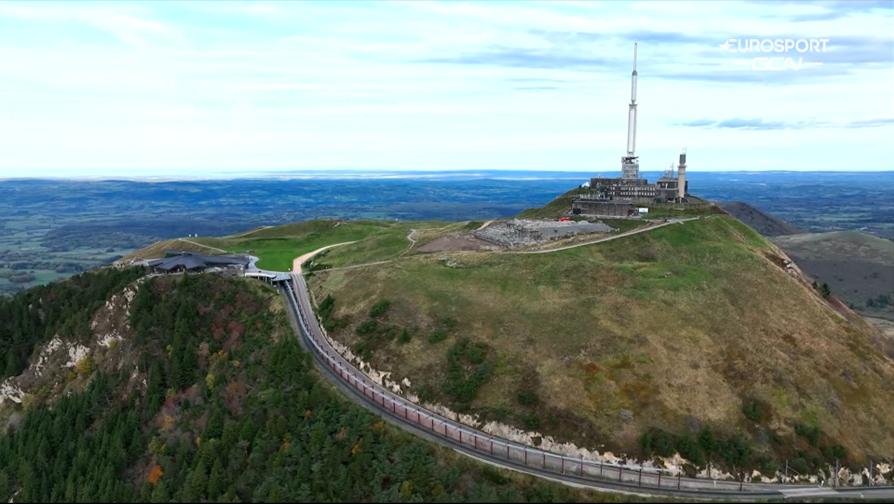
Tour de France finally returns to legendary – and brutally steep – Puy de Dôme after 35-year absence
One of cycling’s dormant legends, the Puy de Dôme, will explode back into life at next year’s Tour de France. The Massif Central’s mythical dome-shaped volcanic plug, jutting high above Clermont-Ferrand, will make its first appearance at the Grande Boucle for 35 years on stage nine of the 2023 Tour, organisers ASO confirmed at this morning’s route presentation in Paris.
The race’s return to the Puy de Dôme, long thought impossible by the construction of a rail line, shrinking the road, in 2012, will form the centrepiece of what will surely be a men’s Tour for the climbers, featuring only 22km of rather hilly time trialling. Both the men’s and women’s races (which are previewed below) will tackle the iconic Col du Tourmalet, as the Tour de France Femmes ventures into the Pyrenees after last year’s focus on the Vosges.

Though the men’s route contains more than its fair share of climbing – including a prolonged, almost week-long stay in the Alps – all eyes will be on a volcano in the middle of the country long thought to be extinct, in racing terms anyway.
Ask any pro cycling fan, ‘what’s the most romantic, emblematic Tour de France climb?’, and you’ll get a dozen or so different answers and opinions. Most of which will be wrong.
It’s not Alpe d’Huez, the ‘Wembley of cycling’, a climb so gainfully employed by the Tour since the 1970s that it became almost too familiar, to the extent that race organisers ASO have reduced it to a freelance role in recent years. What about the doyennes of the Alps and Pyrenees, the Galibier and the Tourmalet? Nah. Mont Ventoux is certainly in with a shout, its occasional use and aura allowing it to retain its inherent sense of mystique and drama.
Today's nostalgia: 1964 Tour de France Jacques Anquetil and Raymond Poulidor #cyclinglife #cyclelife #cyclingvideos #cyclistsofinstagram #cyclingpics #cyclists #cyclingstyle #cyclingphotos #cyclistlifestyle @sarpergunsal @berkemceylan @seytanarabasi @canereler pic.twitter.com/HlAkXkh7Eo — Gökhan Derin (@cyclist_merch) August 14, 2019
But for anyone in their 30s or younger, the Puy de Dôme represents a mothballed snapshot of a bygone era of professional cycling and the Tour de France, a romanticised moment (imagined or otherwise) of the sport captured in time, before EPO, Lance, and the Sky train.
It has played host to some of the sport’s most symbolic, transcendental moments, from Fausto Coppi’s win on the climb’s debut in 1952 to Bernard Hinault’s first stamp of authority on the Tour in 1978 (and, incidentally, the Badger’s final concession to teammate and heir apparent Greg LeMond in 1986).
The Puy was also the scene of the beginning of the end of one of cycling’s defining eras. In 1975, Eddy Merckx, aiming for his sixth Tour win and momentarily succeeding in keeping Lucien Van Impe and home favourite Bernard Thévenet within arm’s reach on the summit finish, was punched in the kidneys by spectator Nello Breton. Injured from the impact of Breton’s ‘accidental’ intervention, the Cannibal’s reign at the top of his sport would end in Pra-Loup two days later.
Eddy Merckx & Joop Zoetemelk dans le Puy de Dome (Tour 1975). Dans quelques km un imbécile va frapper le champion belge... 📸 MC #EddyMerckx #Zoetemelk #PuydeDome #TDF #TDF1975 #TDF2023 #cycling pic.twitter.com/Iw0nVjAOoi — Miroir du Cyclisme 🇺🇦 (@Miroir2Cyclisme) October 4, 2022
However, there is one day, one image, and two racers, that encapsulate the Puy de Dôme’s lofty standing in Tour lore more than any others. In 1964 Maître Jacques Anquetil was four Tours to the good, an imperious, undroppable, but not extremely popular presence at his home race. Meanwhile, the younger Raymond Poulidor, who finished third overall two years before, had emerged as his closest rival for the yellow jersey, and the true owner of the French public’s affections.
By the final mountain stage of the 1964 race, to the summit of the Puy, the two Frenchmen – representing to fans the polar extremes of a cyclist’s character: one a relentless winning machine, the other a charismatic underdog – were separated by only 56 seconds on the GC.
While Julio Jiménez and Federico Bahamontès tore off up the ever-steepening road to the top of the volcano, the stage win and mountain points in mind, Poulidor and Anquetil remained locked together behind, literally shoulder to shoulder, matching each other pedal stroke for pedal stroke.
Was Anquetil bluffing, riding alongside his rival in an attempt to conceal his discomfort and to dissuade the overly cautious Poulidor from attacking? We’ll never know, but when Poulidor finally unleashed his killer blow – within sight of the summit – he managed to put 42 seconds into the battling, for once ragged Anquetil in under a kilometre.
Despite the pyrotechnics, it was all too little, too late: the defending champion remained in yellow – by 14 seconds. “That’s 13 more than I need,” he said at the finish. As Maître Jacques slumped exhausted onto the bonnet of his team manager’s car at the top of the volcano, the myth of Anquetil and Poulidor’s rivalry – and of the Puy de Dôme – was born.
The black and white photo of Anquetil and Poulidor going shoulder to shoulder on the Puy de Dome in 1964 is one of cycling’s most treasured images, but here they are, in colour, on that same climb. PouPou’s shoulders are the closest he’d get to wearing yellow on the Tour. pic.twitter.com/alPZlPCqLu — Felix Lowe (@saddleblaze) November 14, 2019
However, all good things must come to an end, for three and a half decades anyway. By the late 1980s, the continued expansion of the Tour into a global behemoth, with its cavalcade of vehicles and infrastructure, had made hosting the race on the Puy de Dôme a logistical nightmare, a difficulty only enhanced by the construction of a rail line to the summit in 2012, further shrinking the already narrow road.
While it was still used by adventure races such as the Transcontinental, where it hosted the 2017 edition’s first checkpoints, the Puy’s days as a Tour summit finish were thought to be long gone.
But now, as Christian Prudhomme told us this morning, after 35 long years, it’s finally back at the Tour. So what should we expect next summer?
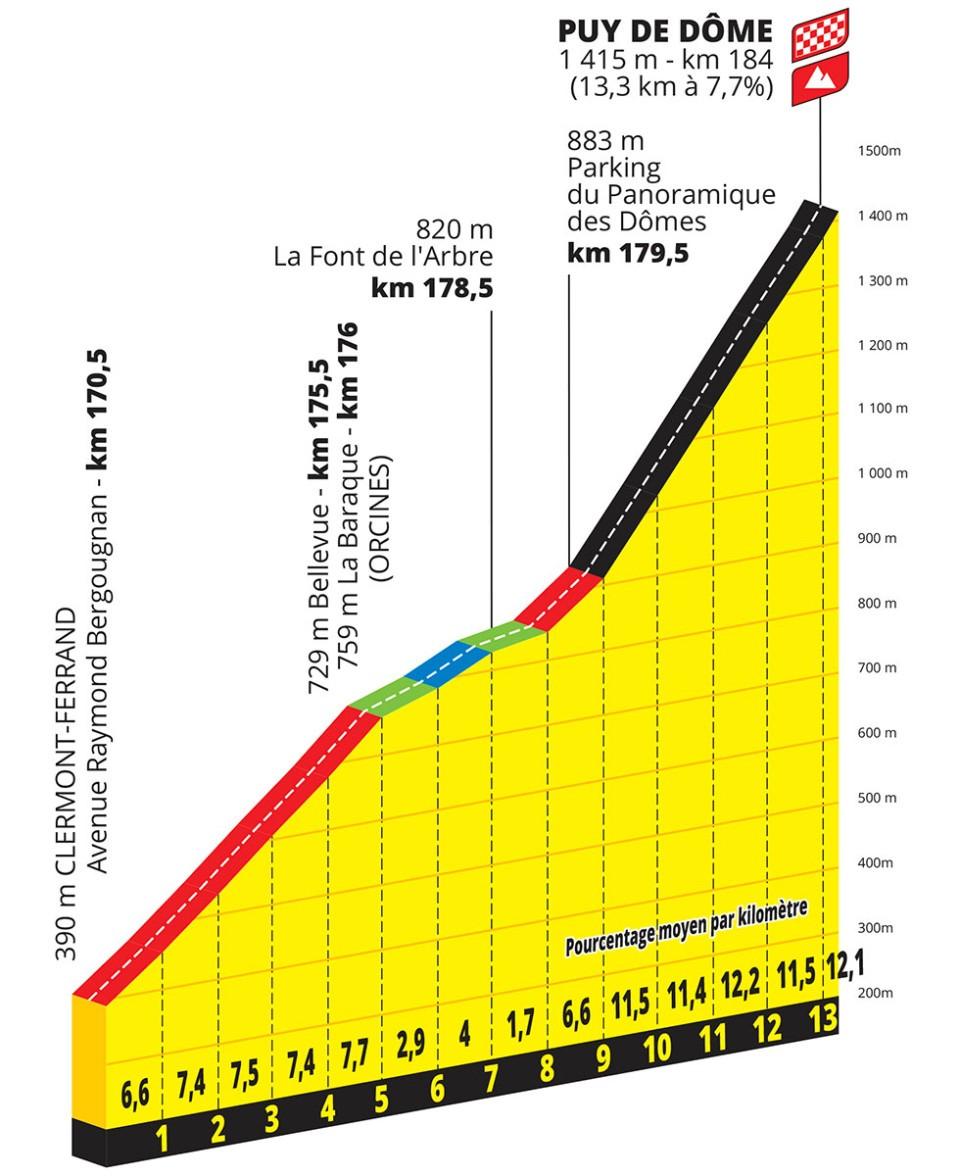
Well, first of all, don’t be expecting Mathieu van der Poel to emulate his grandfather on the volcano’s fearsome slopes (though you never know with MVDP). Because the Puy de Dôme is a relentless monster of a climb.
Rising sharply enough out of Clermont-Ferrand – which will help whittle down the peloton before the road steepens and narrows towards the summit – the road then eases off for three kilometres of relative false flat before stage nine’s defining moment on the dome.
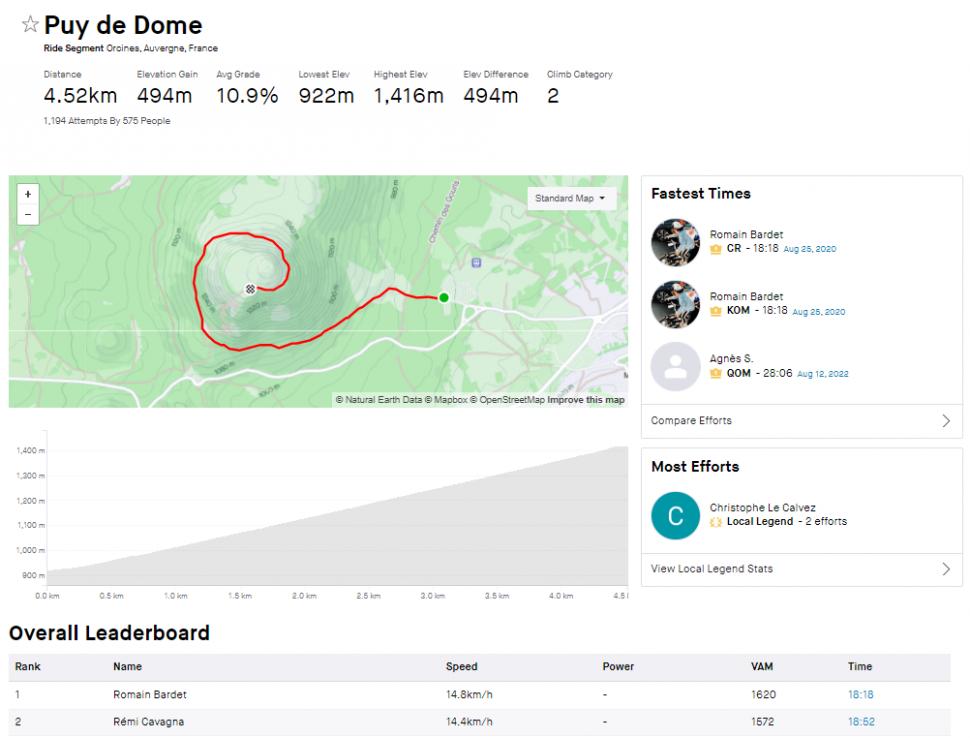
The final four kilometres are, it’s safe to say, savage. According to VeloViewer, the unrelenting gradient never dips below 11.5 percent, and touches 16 percent in places. It may not be the longest climb, but it will certainly do some damage, and will likely favour a climber capable of withstanding steep gradients while retaining some sort of kick at the end. A Tadej Pogačar then, or perhaps a home victory for Romain Bardet (the current Strava KOM )?
Regardless of who comes out on top next summer, by saving the Puy de Dôme from extinction, Tour organisers ASO have once again succeeded in marrying innovation with the race’s storied past.
The 2023 Tour routes
So, what’s happening with the rest of next year’s Tour routes?
Well, the men’s race is a bit of an odd one, to say the least. It’s certainly not what could be described as a Tour of France, missing as it does great swathes of the south-east and basically the entire north of the country.
The condensed nature of the route, focusing heavily on the Pyrenees, Massif Central and the northern Alps, notably means that there is only one lengthy 500km transfer – take note, Giro organisers – from the penultimate, potentially decisive stage to Le Markstein (the scene of Annemiek van Vleuten’s devastating long-range attack to take her first yellow jersey last year) to Paris.
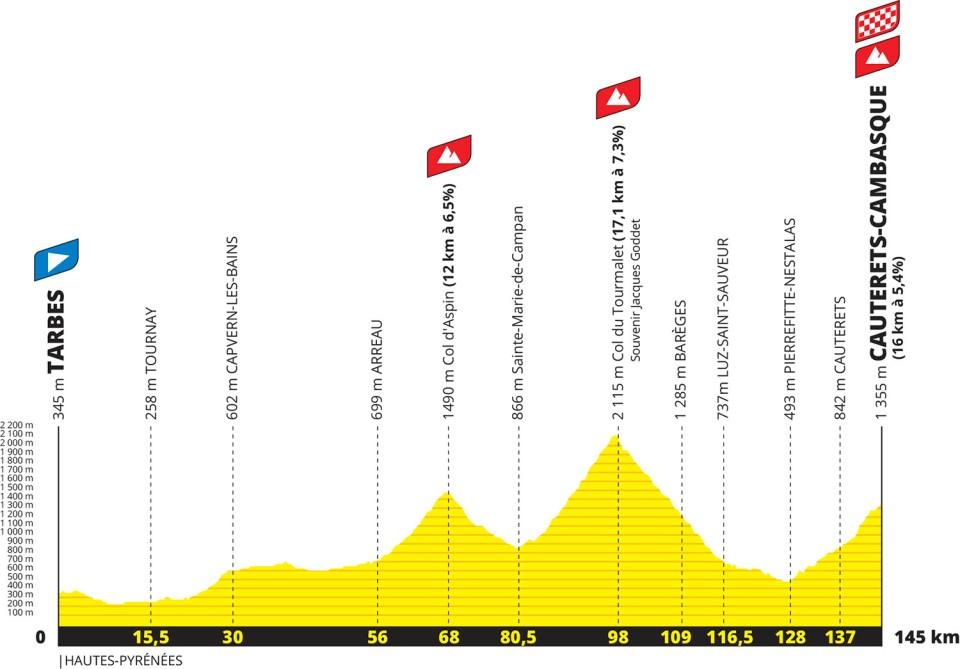
A hilly start in the Basque Country – the Tour’s second foreign Grand Départ in as many years – lends itself to an opening week resembling that of the 1992 Tour, which also began down the road from Bilbao in San Sebastián. The Tour’s southern opening, like in 1992, necessitates an early and relatively benign two-day spell in the Pyrenees before the race’s second weekend (though I’m not sure the riders would agree with me describing a stage featuring the Tourmalet as ‘benign’). A lumpy weekend in the Massif Central, culminating in the aforementioned Puy, will then take the riders into the first rest day.
A varied week two features a few opportunities for the puncheurs and sprinters before a trio of Alpine delights, including summit finishes at the Grand Colombier (on Bastille Day) and Saint-Gervais, while the dreadfully steep Joux Plane acts as the focal point of stage 14 – and next year’s Étape du Tour – before the fast, hairy plunge into Morzine. Have fun, if you're planning on riding that!

The final week kicks off with the only time trial of the race, a hilly 22km affair featuring the Côte de Domancy, where Bernard Hinault stormed to the rainbow jersey in 1980. The 2023 Tour is certainly not kind to the time triallists – only 2015 had fewer individual time trialling kilometres in the post-war period, and even it had a team effort – an observation underlined by the following stage’s inclusion of the Col de la Loze, the roof of the race and the scene of Tadej Pogačar’s brief wobble in 2020.
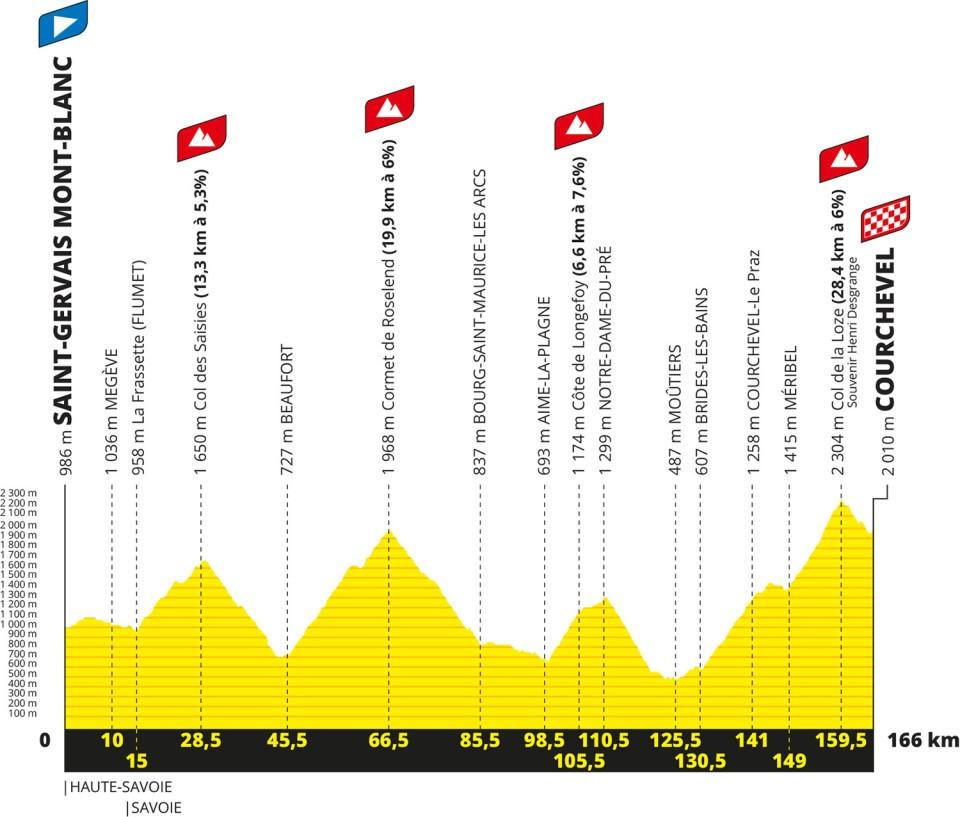
The route is, however, more favourable to the sprinters ( for once ). There are nine potential stages for the fast men, an apparent reversal of ASO’s anti-bunch kick bias in recent years. Two final-week flat transition stages (a rarity in the modern Tour) will take the riders to the Vosges for what the organisers will hope is a decisive, suspense-filled penultimate day.
> No Country for Fast Men: Why is this year’s Tour de France so unkind to sprinters?
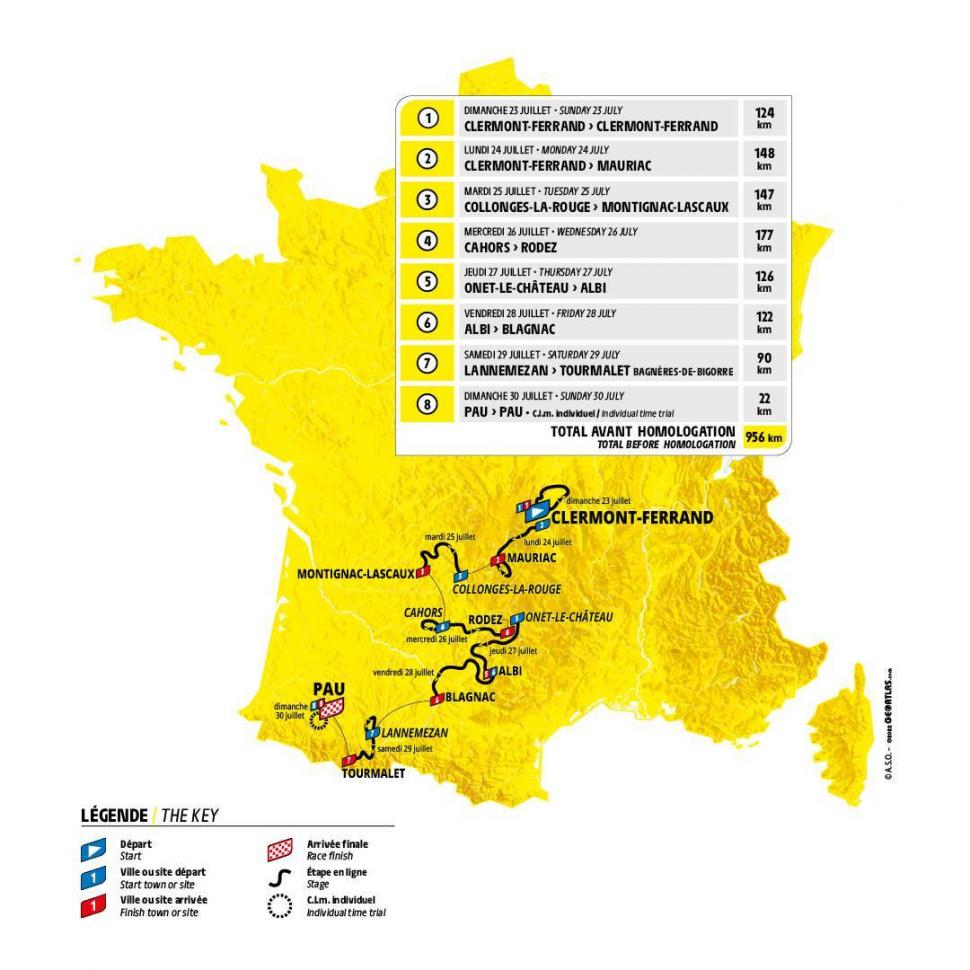
Meanwhile, suspense will almost certainly be the name of the game in next summer’s Tour de France Femmes , the second edition of the revamped women’s race.
While last year’s race stuck to the north of the country, the 2023 route ventures south for what should be a thrilling final weekend in the Pyrenees. After providing base camp for the men as they tackle the Puy de Dôme two weeks earlier, Clermont-Ferrand will again play a starring role in the Tour Femmes, kicking the eight-day race off with a flat opening stage that Lorena Wiebes will surely have marked in her calendar.
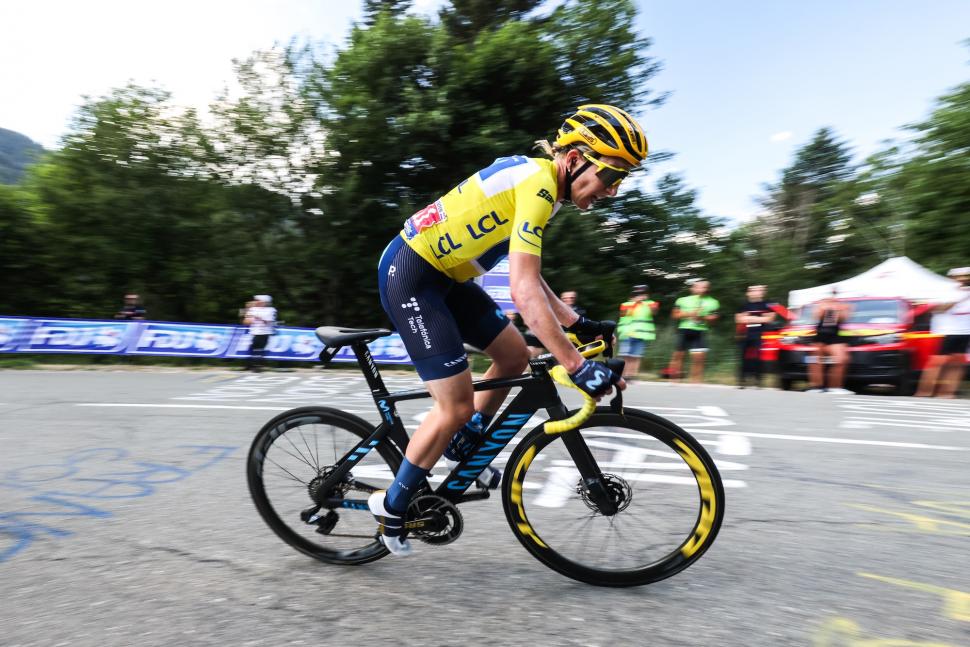
ASO/Fabien Boukla
The second stage to Mauriac is a grippy introduction to the hills, while the final ramp to the line will provide an early GC shakeup. Another sprinters’ stage to Montignac-Lascaux will precede a biting, hilly finale into Rodez, tailor made for the puncheurs. Rodez will also offer the final opportunity for the less-than-confident climbers (i.e. anyone but Annemiek van Vleuten) to take time before the Pyrenees, as two flat stages to Albi and Blagnac transport the peloton south into the mountains.
Stage seven of the 2023 Tour de France Femmes may only be 90 kilometres long, but it’s a classic Tour stage. The Col d’Aspin, first tackled in the men’s race in 1910, acts as the amuse-bouche (well, a 12 kilometre amuse-bouche, anyway) before the peloton ascends to the summit of one of the Tour’s iconic climbs, the 17km-long, 7.3 percent Col du Tourmalet. Expect fireworks – probably from a Dutchwoman in a Movistar jersey – on what will surely be a defining day for the race, and a symbolic moment for the women’s side of the sport too.
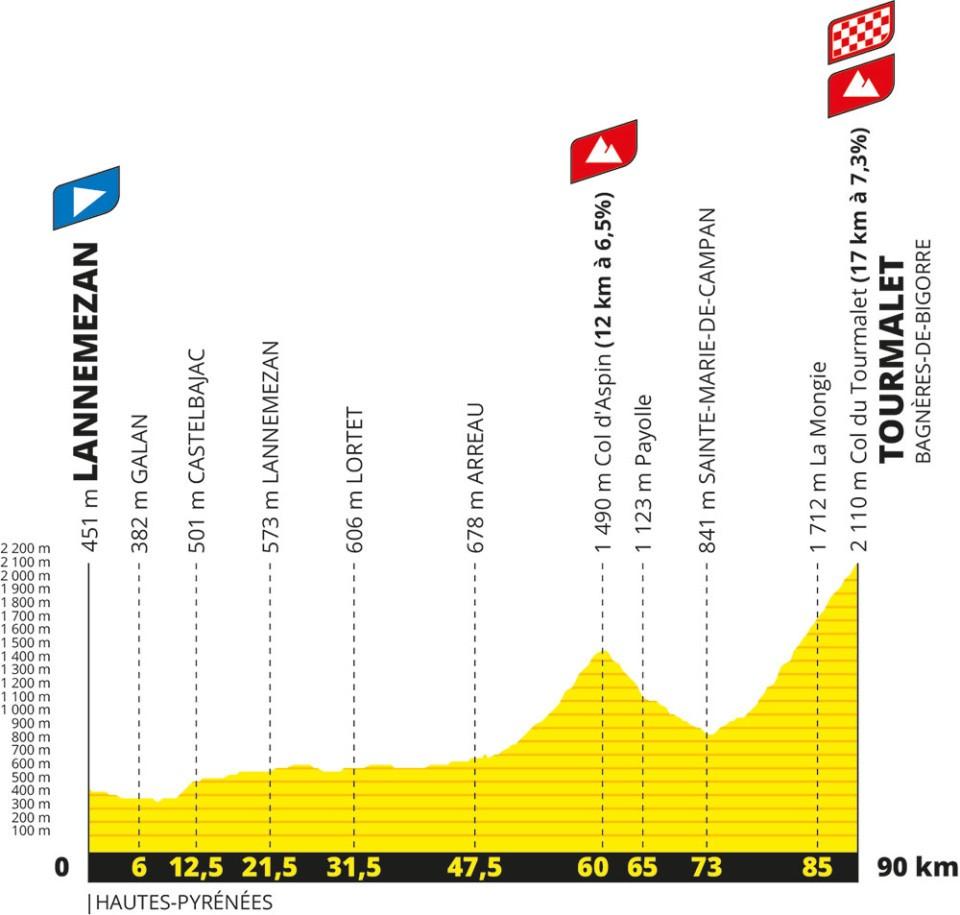
If Van Vleuten hasn’t blown the race apart on the Tourmalet, her rivals will have one more chance to usurp the defending champion during the final day’s 22km time trial in Pau. The gateway to the Pyrenees has hosted the men’s race 74 times (third in the all-time list behind Paris and Bordeaux), and will provide a fitting conclusion to four weeks of top-tier racing.
Let’s just hope we’re treated to a suspense-filled final day against the clock, and not any of the other, more murky goings-on associated with the men’s sojourns in Pau down the years…
Help us to fund our site
We’ve noticed you’re using an ad blocker. If you like road.cc, but you don’t like ads, please consider subscribing to the site to support us directly. As a subscriber you can read road.cc ad-free, from as little as £1.99.
If you don’t want to subscribe, please turn your ad blocker off. The revenue from adverts helps to fund our site.
Help us to bring you the best cycling content
If you’ve enjoyed this article, then please consider subscribing to road.cc from as little as £1.99. Our mission is to bring you all the news that’s relevant to you as a cyclist, independent reviews, impartial buying advice and more. Your subscription will help us to do more.
Ryan joined road.cc in December 2021 and since then has kept the site’s readers and listeners informed and enthralled (well at least occasionally) on news, the live blog, and the road.cc Podcast. After boarding a wrong bus at the world championships and ruining a good pair of jeans at the cyclocross, he now serves as road.cc’s senior news writer. Before his foray into cycling journalism, he wallowed in the equally pitiless world of academia, where he wrote a book about Victorian politics and droned on about cycling and bikes to classes of bored students (while taking every chance he could get to talk about cycling in print or on the radio). He can be found riding his bike very slowly around the narrow, scenic country lanes of Co. Down.
Add new comment

Quote: The condensed nature of the route, focusing heavily on the Pyrenees, Massif Central and the northern Alps, notably means that there is only one lengthy 500km transfer – take note, Giro organisers
Again, as I said when the Giro route was announced, I don't understand why the Giro is getting it in the neck so much about this. OK, their final day transfer is 700km rather than 500km, but otherwise the transfers look about the same. Last year the Tour did the massive transfer from Denmark to France and I don't recall anyone mentioning its environmental impact, why has the Giro suddenly become the whipping boy for something all the GTs do?
- Log in or register to post comments
Very excited about this. I rode up it in 2019 and the last 4.5km are steep. Ever since, I have hoped that it might make a return to the Tour one day.
ooblyboo wrote: Very excited about this. I rode up it in 2019 and the last 4.5km are steep. Ever since, I have hoped that it might make a return to the Tour one day.
Did you get in on the lottery? I applied for a couple of years but without luck, would love to have had a crack at it.
Yes - 2019 I think it was. Really pleased to have done it. The Auvergne, including the Cantal further south offers some fantastic climbs. Puy Mary is my other favourite.
ooblyboo wrote: Yes - 2019 I think it was. Really pleased to have done it. The Auvergne, including the Cantal further south offers some fantastic climbs. Puy Mary is my other favourite.
I'm going to get there one of these years, hopefully some climbing combined with watching Clermont Auvergne play rugby.
Latest Comments
...and of course in the final analysis cycling infra is "driving infra" (if it's good)!...
As chrisonabike says, the police don't take kindly to booby-traps (it would be vigilantism). There's also the problem that you'd be locking the...
The Look KG 196 (1990 onwards) was a carbon monocoque frame and I think Vitus and Peugeot both had monocoque carbon frames on the market by '94.
Not quite comparable. The Caledonia is a bit longer and lower. It's more of an all-road bike too while the Forge very much rides as a race bike....
I have 2 questions about this:...
Burnham Market is one of those weird posh coastal town places overrun with 2nd home owners from the Borough of Kensington & Chelsea. So those...
Wait, I'm confused.... I thought the casuals/ hard working Putinbots had determined that we are tree hugging, Grauniad reading, tofu munching,...
Also available for sending up on the "Drivers and their problems" thread....
I wondered what the BBC did with their leftover Doctor Who costumes… Looks just like a Fomori from 'The Leisure Hive'
I always said I didn't want the faff of electronic shifting, and then I accidentally bought an electronic-only frame during the pandemic, with the...

IMAGES
COMMENTS
The 1964 Tour de France was the 51st edition of the Tour de France, one of cycling's Grand Tours.It took place between 22 June and 14 July, with 22 stages covering a distance of 4,504 km (2,799 mi). Stages 3, 10 and 22 were all two-part stages with the first half being a regular stage and the second half being a team or individual time trial.It was the only Tour de France to include a mid ...
Stage 20 of the 1964 Tour was some 237km in length, but in reality, the day was mainly a long preamble towards the moment of truth awaiting the two protagonists atop the dormant volcano brooding ...
Jacques Anquetil is a cycling legend. He was the first person to win the Tour five times. In 1961, he gained the yellow jersey in stage 1 and held onto it all the way to the last stage. He was a dominant force. He was the man to beat in 1964. His rival, Raymond Poulidor, was raised on a farm and had a huge natural talent.
The long-awaited return of the legendary Massif Central climb, the scene of Raymond Poulidor and Jacques Anquetil's iconic battle in 1964, adds another layer of nostalgia to the modern Tour de France when stage nine visits on Sunday. One of cycling's dormant legends, the Puy de Dôme, will explode back into life on stage nine of the 2023 ...
La 20e étape du Tour de France 1964 a eu lieu le 12 juillet 1964 entre Brive-la-Gaillarde et Clermont-Ferrand / Puy de Dôme, en France, sur une distance de 237,5 km. Elle a été remportée par l'Espagnol Julio Jiménez. Cette étape est surtout marquée par la lutte que se livrent les deux protagonistes pour la victoire finale de ce Tour de ...
A look back on a historic duel between two greats, Raymond Poulidor and Yellow Jersey Jacques Anquetil !
Stage 20, with its finish at the top of the Puy de Dôme, was the scene of the 1964 Tour's most dramatic showdown. The Puy de Dôme is an extinct volcano in the center of France. It has an elevation gain of 515 meters in only 6 kilometers. It averages 9%, but gets steeper as the road approaches the summit.
Tour de France 12 juillet 1964, le duel mythique du Puy de Dome entre Anquetil et Poulidor TOUR DE FRANCE - C'est sans doute l'un de smoments les plus mémorables de toute l'histoire de la Grande ...
One day One story - 1964: A duel at the summit on the Puy-de-Dôme. The 2020 Tour was originally scheduled to take place from 27 June to 19 July. To keep the flame of the race burning, letour.fr will relive every day a glorious or curious race event that happened two, fifteen or forty years ago. A trip down memory lane…. Anquetil versus ...
Le Tour de France 1964 est la 51 e édition du Tour de France, course cycliste qui s'est déroulée du 22 juin au 14 juillet 1964 sur 22 étapes pour 4 504 ... Jacques Anquetil remporte l'épreuve après un duel homérique avec Raymond Poulidor, notamment sur les pentes du Puy de Dôme.
C'est sans doute l'un des moments les plus mémorables de toute l'histoire de la Grande Boucle. Jacques Anquetil et Raymond Poulidor, à la lutte pour le maill...
Jacques Anquetil (left) and Raymond Poulidor duel for the lead during the epic climb up Puy de Dome on 12 July 1964. ... and Joop Zoetemelk climb Le Puy de Dôme during the 1976 Tour de France.
L'une des étape les plus mythiques du Tour de France, celle où le duel entre Jacques Anquetil et Raymond Poulidor a atteint son paroxysme.
The Puy de Dôme made its debut in the race in 1952 when Fausto Coppi was victorious on the way to a dominant Tour de France victory. ... the climb 48 hours before the end of the 1964 Tour de ...
Le Français Jacques Anquetil (G), maillot jaune de leader, est au coude à coude avec son compatriote Raymond Poulidor dans l'ascension du Puy de Dôme, le 12 juillet 1964 lors de la 20ème ...
The inclusion of the Puy de Dôme in the Tour de France began with an unforgettable climb in 1952. The legendary Italian cyclist, Fausto Coppi, took the lead, breaking away 6 kilometres from the finish line to claim the first-ever victory atop the Puy de Dôme. ... In 1964, the mountain was witness to the historic duel between two titans of ...
By the time they came to the final mountain stage, 217km from Brive to Puy-de-Dôme, Anquetil was still 56 seconds ahead of Poulidor in the GC. With just two plain stages and a time-trial to ...
Julio Jiménez is the winner of Tour de France 1964 Stage 20, before Federico Martin Bahamontes and Raymond Poulidor. Jacques Anquetil was leader in GC. ... 1964 » Stage 20 » Brive › Puy de Dôme (217km) Stage; GC; Age BIBs GC +Points Time won/lost H2H Specialty clear filter ...
While the Tour de France has summited the Puy de Dôme 12 other times, including the climb where Eddy Merckx was punched in the yellow jersey as he was going for his sixth Tour victory in 1976 - a fascinating story, but one for another day - 1964 stands out in the context of modern cycling because it was such a precursor to the dynamics in ...
Tour de France 1964 - Le Puy de Dôme, théâtre du mythique duel Poulidor - Anquetil en 1964 C'est sans doute l'un des moments les plus mémorables de toute l'histoire de la Grande Boucle.
This document takes you back to 1964 when the 51st edition of the Tour de France was won by Jacques Anquetil, after a legendary duel with Raymond Poulidor. About us ... De Rennes au Parc des Princes, de Forest à Andorre, de Brive au Puy-de-Dôme, cet ouvrage original aujourd'hui quasiment introuvable, permet de redécouvrir avec une ...
One of cycling's dormant legends, the Puy de Dôme, will explode back into life at next year's Tour de France. The Massif Central's mythical dome-shaped volcanic plug, jutting high above Clermont-Ferrand, will make its first appearance at the Grande Boucle for 35 years on stage nine of the 2023 Tour, organisers ASO confirmed at this morning's route presentation in Paris.
An iconic dormant volcano in central France, the Puy de Dôme returns to the 2023 Tour de France for the first time in decades.. After being excluded for over three decades, the famously steep and challenging climb of Puy de Dôme has once again been announced in the route for the 2023 Tour de France.. The Puy de Dôme has been the site of many memorable moments in Tour de France history, and ...